Henry Jenkins's Blog, page 6
May 20, 2024
WrestleMania XL: The Greatest Story Ever Told (Part One)
By Tara Lomax and Mark Williamson
This is the first of three parts on the recent WrestleMania XL and the current revival of WWE. It reviews the interconnected and multistrand storytelling that unfolded over two years leading into the recent event and highlights opportunities for further appraisal. This first part establishes the important role of audience and character in pro wrestling, and overviews key moments for Roman Reigns leading into WrestleMania XL. The second part reflects on long form serialized storytelling in WWE and introduces the story of Cody Rhodes. The third part explores the blurring of reality and fiction that drives pro wrestling storytelling and the role it played in the lead up to WrestleMania XL. Readers who might be interested in this piece include those new to pro wrestling within the context of popular culture and entertainment studies and those curious about WWE’s revival. Italicized text denotes wrestling terms.
World Wrestling Entertainment (WWE) is in the midst of a revival. This rejuvenation of WWE is a result of new ownership (Endeavor purchased WWE in 2023 and formed The TKO Group with UFC), new creative leadership (Paul ‘Triple H’ Levesque became Chief Content Office [CCO] in 2022), and the return of ‘The American Nightmare’ Cody Rhodes at WrestleMania 38 (2022). WWE’s renaissance has emerged over the past two years and follows a period of economic and creative decline for the company (largely driven by the pandemic but not entirely), so this resurgence is welcomed by the wrestling business and the WWE Universe (its fanbase); it is also significant for the entertainment industry and its study because it shows what can be achieved when creators reconnect with the distinctiveness of the medium, its history and its audience. Over three parts we will explore the significance of WrestleMania XL (2024), the serial storytelling that led to the event, and its affirmation of a new era for WWE and professional wrestling.
What is Professional Wrestling?Professional wrestling – or pro wrestling – is a form of live storytelling that revolves around staged combat in a wrestling ring, otherwise called “the squared circle”. In this form, storytelling emerges through the blurring of reality and fiction as pro wrestlers adopt archetypal personas (gimmicks) and form rivalries based on two principal character roles: the babyface (or face) and the heel. These roles are often understood as protagonists (or heroes) and antagonists (or villains) that are associated with storytelling more generally, but the function of these roles is more nuanced in pro wrestling: the babyface and the heel are defined by a relationship with audience.
While it might be easy to simply label the babyface as a heroic ‘goodie’ and the heel as a villainous ‘badie’, this does not quite account for the distinct relationships that form between babyfaces and heels and how the audience can influence these characters and their stories. A heel can be morally ‘good’ and still be a heel if they deny the audience something, or a babyface can behave immorally and be cheered, as with the double turn of Bret ‘The Hitman’ Hart and ‘Stone Cold’ Steve Austin at WrestleMania 13 (1997). Heels can still be very popular, despite their presentation, as with ‘Rowdy’ Roddy Piper, Ric Flair, Austin, and The Rock. Pro wrestlers can also move back and forth between these roles based on booking (match and story producing) and audience response. A face that gets a pop and a heel that gets heat signal a successful synergy between the audience and the story (inside and outside the ring).
For most mainstream commentators, pro wrestling’s “fakeness” is a shroud that obscures appreciation of its distinct storytelling qualities and medium specific conventions. This idea of “fakeness” in relation to pro wrestling is really about an ambiguous relationship between fiction and reality, which can be a complex dynamic to manage creatively. WWE storytelling occupies this ambiguous threshold between the real and the scripted through distinctive character types, cause and effect driven by staged (not fake) combat, serialized narration, and audience participation. This is all exemplified by the road to WrestleMania XL.
What is WrestleMania?WrestleMania is an annual event produced by WWE (formerly WWF) that began in 1985. It is the flagship event of WWE programing that all premium lives events (PLEs) – formerly pay-per-views (PPVs) – revolve around. Historically, each year the “Road to WrestleMania” begins at the Royal Rumble; since WrestleMania XL celebrates the event’s 40th anniversary, this event also culminates 40 years of WWE history. It is also the first WrestleMania without a member of the McMahon family running WWE.

Image 1: WrestleMania XL held at Lincoln Financial Field in Philadelphia (April 6-7, 2024)
Taking place in Philadelphia over two nights on April 6 and 7 2024 and live streamed internationally (image 1), WrestleMania XL broke records including highest attendance and Peacock’s most-streamed entertainment event. According to CCO ‘Triple H’, it is “by every metric the biggest WrestleMania of all time”. What made this WrestleMania so notable is that it was built on a Main Event invested in serialized storytelling that harnessed its relationship with audience. This story is about the babyface, ‘The American Nightmare’ Cody Rhodes – son of the pro wrestling legend, ‘The American Dream’ Dusty Rhodes – finally defeating the long-reigning heel, ‘The Tribal Chief’ Roman Reigns, who is a member of the Anoa’i family and descendent of the great Samoan wrestling dynasty that includes The Rock. Over three parts, this piece explores key moments in this story and its culmination at WrestleMania XL. This part focuses on the story of Reigns, the next part will explore the key moments for Rhodes and the final part will discuss the inclusion of The Rock in the final stage in the story of WrestleMania XL.
Video 1: WrestleMania XL (2024) teaser trailer
Roman Reigns: Heel, Champion, ‘The Tribal Chief,’ ‘Head of the Table’Going into WrestleMania XL, Roman Reigns had been champion for 1316 days with the help of his manager ‘The Wise Man’ Paul Heyman and his faction ‘The Bloodline’. Over his reign, he developed a reputation for being manipulative, narcissistic, ruthless, and sadistic; his behavior resembled a crime boss more than a pro wrestler, as he ordered ‘The Bloodline’ – his family – to attack opponents and interfere in matches. Through these tactics, Reigns defeated all who challenged him, including Daniel Bryan, Finn Bálor, John Cena, Goldberg, Rey Mysterio, Edge, Randy Orton, Brock Lesnar, Drew McIntyre, Kevin Owens, Sami Zayn, Logan Paul, and Cody Rhodes – the best of the WWE roster. Reigns built an empire around this domination and demanded that all of WWE acknowledge him as ‘The Tribal Chief’ and leader of WWE (Image 2). By all accounts, Reigns as ‘The Tribal Chief’ exemplified the most archetypal version of the heel as ‘bad guy’, but what the climax of WrestleMania XL reveals is the story of a man broken down by a history of insecurity, betrayal, and rejection.

Image 2: ‘The Bloodline’ (L-R: The Rock, Jimmy Uso, Roman Reigns, Solo Sikoa, and Paul Heyman) and the WWE Universe (the fandom) acknowledging Roman Reigns as the ‘The Tribal Chief’ on Smackdown (March 1, 2024).
Reigns was previously a member of a babyface faction called ‘The Shield’, together with Seth Rollins and Dean Ambrose. ‘The Shield’ had been in a feud with ‘The Authority’, a heel faction principally made up of ‘Triple H’, Vince McMahon, and Stephanie McMahon with associate members including Orton, Kane, and Batista. ‘The Shield’ broke up on Raw in 2014 when Rollins joined ‘The Authority’ after hitting Reigns in the back with a steel chair and making a heel turn (video 2). This is a linchpin moment in Reigns’ story that will continue to repeatedly haunt him.
Video 2: Rollins hits Reigns with a chair on Raw (June 2, 2014).
Over the years that followed the break-up of ‘The Shield’, Reigns was booked as the top babyface of WWE, to mixed audience responses. His appearances at major events, including the Royal Rumble (2015), WrestleMania 33 (2017), and the “Raw after Mania” (2017), were met with loud groans – this was not heat for a heel, but a rejected babyface (video 3).
Video 3: Reigns is booed on Raw (April 3, 2017)
This fraught relationship with the audience continued until 2018 when he announced a break from WWE to treat leukemia (which he had been battling privately for 11 years prior). His return in 2019 was met with some cheer, but he was still not fully embraced as a leading babyface. This points to a further dimension in the relationship between storytelling and audience in pro wrestling: the perception of audience agency and story causality. It was not necessarily Reigns himself who the audience rejected, but the consistent presentation of him as an unstoppable babyface, despite their vocal disapproval.
Like with all forms of live entertainment, the pandemic put WWE and WrestleMania at risk of collapse: WrestleMania 36 (2020) took place in the WWE Performance Centre where the only fan in sight was a ceiling fan. During this period, WWE trialed multiple ways to simulate the audience or facilitate their remote engagement, from the digital faces of the ThunderDome to piped-in sound, but it remained clear that pro wrestling is nothing without a live audience (image 3).

Image 3: (Left) WrestleMania 36 (2020) in an empty WWE Performance Centre; (right) Digital faces of the ThunderDome.
For Reigns, the coronavirus outbreak posed a higher health risk and so he took a five-month hiatus, which allowed him to also reassess his career and consider retirement. During WWE’s time of crisis, Reigns fortunately returned with a new heel attitude and a manager, Heyman (Image 4). In his return match at Payback (2020), he won the WWE Universal Championship in a “Triple Threat” match with ‘The Fiend’ and Braun Strowman (image 5).

Image 4: Reigns returns with Heyman on SmackDown (August 28, 2020)

Image 5: Reigns (with Heyman) wins the WWE Universal Championship at Payback (2020)
After years of resisting the audience’s disapproval, the heat was now in sync with booking intensions. Reigns had fully embraced his new heel role, to the point that he would inflict brutal violence on his own cousins – twins Jey Uso and Jimmy Uso – to show his dominance and make them subservient. At Hell in a Cell (2020), Reigns forced Jey Uso to surrender in their “I Quit” match by choking his brother Jimmy Uso and so ‘The Bloodline’ and Reigns as ‘The Tribal Chief’ were born (Video 4). Reigns would go on to reinforce his dominance in a feud with Lesnar to also win the WWE Championship in a “Winner Takes All” Main Event at WrestleMania 38 (2022) to become the Undisputed WWE Universal Champion (image 6).
Video 4: Reigns defeats Jey Uso at Hell in a Cell (2020)

Image 6: Reigns becomes Undisputed WWW Universal Champion at WrestleMania 38 (2022)
The development of ‘The Bloodline’ involved multiple story angles and archetypes, as Sami Zayn was introduced as the outsider looking for protection and Solo Sikoa (The Uso’s younger brother) took on the role as sadistic enforcer. Bestowed with the title of ‘Honorary Use’ to recognize this allegiance to ‘The Bloodline,’ Zayn was driven to prove his loyalty by sacrificing his long-term friendship with Kevin Owens at Survivor Series: WarGames (2022). This loyalty was put into question again: in the aftermath of Reigns defeating Owens in the Main Event at the 2023 Royal Rumble, Zayn was ordered to bludgeon Owens with a steel chair; instead, Zayn picked up the chair and – harking back to Rollins in 2014 – hit Reigns in the back, thus ending his allegiance with ‘The Bloodline’ (video 5). While pro wrestling is principally concerned with simulating combat sport, the gangster melodrama quality of the ‘The Bloodline’ story intensified pro wrestling as a serialized soap opera.
Video 5: Zayn hits Reigns with a steel chair at Royal Rumble (2023).

Image 7: Elimination Chamber (2023) poster.
Zayn’s involvement with the ‘The Bloodline’ played a major role in boosting the story’s popularity: it elevated Zayn as a babyface and amplified Reigns as an unstoppable heel. Next to Reigns’ brutal dominance, Zayn represented the underdog and everyman – there was a sense that he had qualities that might just be what was needed to defeat Reigns. However, this hope was lost when Reigns defeated Zayn in his hometown of Montreal in the Main Event at Elimination Chamber (2023) (image 7). Leading into WrestleMania 39 (2023) it became clear that WWE needed a superhero to defeat Reigns (more on this in Part Two).
Tara Lomax is the Discipline Lead of Screen Studies at the Australian Film Television and Radio School (AFTRS). She has expertise in blockbuster franchising, multiplatform storytelling, and contemporary entertainment and has a PhD from the University of Melbourne. She has published on media franchising, the superhero and horror genres, entertainment industries, transmedia storytelling, and stardom. Her work can be found in publications that include the Journal of Cinema and Media Studies (2024, forthcoming), Senses of Cinema and Quarterly Review of Film and Video, and the edited books Starring Tom Cruise (2021), The Supervillain Reader (2020), The Superhero Symbol (2020), Hannibal Lecter’s Forms, Formulations, and Transformations (2020), The Palgrave Handbook of Screen Production (2019), and Star Wars and the History of Transmedia Storytelling (2017). She is on the Pop Junctions editorial committee.
Mark Williamson has over twenty years of experience as a performer, promotor, producer and commentator in Australian professional wrestling. He has booked wrestling promotions including International Wrestling Australia (IWA) and Warzone Wrestling, and produced the series Underworld Wrestling (2018-2019), which streamed on Amazon Prime Video (2018-2022) and is now available on Tubi. As a pro wrestling manager, he worked with former pro wrestler and now WWE Raw General Manager Adam Pearce. More recently he has explored the creative opportunities of pro wrestling storytelling through comic books and audio platforms.
April 24, 2024
Moving Between World(views) with Database Narratives
Great transmedia storytelling shows me that a single piece of media is just one limited window on a larger world. It invites me to imagine a universe that extends far beyond what I can see on screen or understand directly through the text. Telling multiple stories in the same universe, across different media formats, demonstrates that each character, place, or point in history presents just one out of many possible perspectives. To develop our own perspective, we take on board these different points of view and imagine what might exist out there that connects it all, a kind of “blind men and the elephant” exercise
In my chapter in Imagining Transmedia, “Cis Penance: Transmedia Database Narratives,” I discuss my own interactive documentary work about transgender people (specifically, a piece called Cis Penance: Trans Lives in Wait), in terms of concepts that come from Japanese media studies scholarship: database narratives and sekaikan (worldview). These can be considered alongside related concepts such as “storyworld” and “cinematic universe”.
Database narratives (or “database consumption”) is a concept introduced by Hiroki Azuma in the 2001 book Otaku: Japan’s Database Animals to describe a way of relating to media products that had become very prominent in Japanese otaku culture by the late 1990s. To take a well-known example, each Pokémon game, anime, movie, and other media extension contributes to a larger picture of the storyworld, establishing an overarching fictional reality through the narrative device of the Pokédex—though database consumption does not require this kind of in-world database. Database narratives or database consumption can also be observed in Star Trek, the Marvel Cinematic Universe, the Hellaverse of Hazbin Hotel and Helluva Boss, and many more.
Rather than pointing to a singular, overarching “grand narrative” associated with modernism, in database consumption each person creates their own internal database of associations with a storyworld. Although “database” does not refer to a media object in itself—Azuma’s database is a metaphor for an imagined cognitive rendering of a storyworld inside a fan’s head—fan wikis are interesting texts to refer to when making sense of a database narrative, and represent an effort to negotiate a shared metatextual reality with other fans. Azuma’s argument is that otaku do not just consume the text of a particular piece of media, but more broadly consume the world that it portrays: its “sekaikan”.
I am generally grumpy about the introduction of loan words from Japanese into English, because their acquired meaning in English will inevitably come to differ significantly from their associations in Japanese. Part of this is due to the same inevitable semantic drift that plagues all language, but it may also be exacerbated by a strong tendency to exoticise “the Far East”. From “ikigai” to “katsu curry”, we just don’t seem to be able to resist making Japanese words into something they are not.
With that said, I find sekaikan legitimately useful, because it does point to something that is not quite captured by its English and German equivalents (worldview and Weltanschauung, respectively). Sekaikan is not just a set of beliefs about a world, but also how a world is portrayed in a piece of media. In English, we think of worldview as a philosophical position that “underlies” a work, a prior cause from which our narratives emerge. Sekaikan can mean this, but it can also refer to the outcome of a set of creative decisions. Rather than betraying the auteur’s underlying values, the creative process can itself produce a sekaikan, as part of its aesthetic effect. A worldview is something I have, but a sekaikan is something I try to create.
It might also be worth noting that when translating from Japanese to English, you often have to infer from context whether a noun is singular or plural, and whether to apply “the” or “a”. When we talk about worldview, we assume that the “world” in question is the consensual reality that we share with every other living being—there is only one “real world” with reference to which our worldviews are formed. Sekaikan is more freely used to describe how a fictional world is portrayed, independent of any beliefs the authors may have about the real world. Is the sekai of sekaikan “the world”, “a world”, or (many) “worlds”?
Another linguistic pleasure I get from “sekaikan” is that the character that translates to “view” is homophonous with another common suffix that translates to “feeling” or “sense of” (e.g. 疎外感 sogaikan, (feeling of) alienation; or 親近感shinkinkan, (sense of) affinity). Sekaikan does not mean “world feeling”, but it almost feels like it could (perhaps in another world?). Of course, here I’m doing the very thing that frustrates me about loan words—I’m making the word into something it is not, simply because it supports my own sensibilities and interests.
Just as we can construct database narratives about fictional worlds, I think we do the same about our own societies. I came to understand what it means to be a genderqueer person and a transgender man because I encountered the stories of other transgender people, through meeting people in LGBTQ+ community spaces, watching documentaries made by other trans people such as Fox Fisher’s My Genderation project, exploring trans people’s blogs and video-blogs, and playing indie games in the early years of the queer games movement. Each individual story contributes to a larger reality—a world in which gender identity exists independently of sex assigned at birth, gender dysphoria causes significant distress that one might only recognise after unlearning lifelong dissociative habits, and gender euphoria can be experienced by trans and cis people alike. Each testimony adds to my own internal database of things it is possible to feel, be, see and do.
This construction of a sekaikan in which trans lives are possible was part of the purpose of my own work creating interactive documentaries based on oral-history interviews with transgender people. My first such work was created in 2018, when I was an artist in residence in Tokyo with a programme supported by the Japanese Agency for Cultural Affairs. I interviewed transgender people in the Kansai and Kanto areas, and turned each transcript into an interaction with an on-screen character. All the text attributed to that character came verbatim from one of the interviews, but to keep the interaction loop short I invented questions that the user could choose from, employing an interaction pattern seen in many role-playing games.
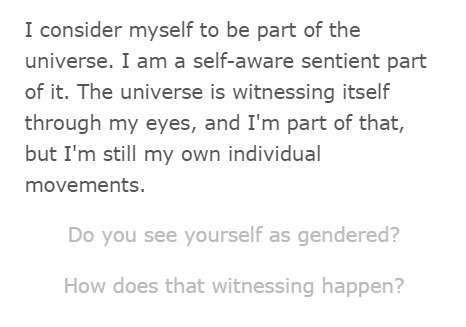
credit: Zoyander Street
Since 2019, I have been working on a piece much larger in scale, based on 45 interviews with transgender people across the UK. I’ve had the pleasure of collaborating with trans artists whom I have admired for many years: for example, the character designs are by June Hornby (a.k.a. Critterdust), who previously created a game called Earthtongue that has you manage an alien terrarium; and the music is by Liz Ryerson (a.k.a. Ellaguro), who has heavily influenced my own worldview on digital art through her vast body of work across indie game development, music, criticism, visual arts, and podcasting.

credit: Zoyander Street
My hope is that Cis Penance initially overwhelms the player with the sheer number of characters, who are arranged as though they are all waiting in line for something. My starting point was thinking about one of the differences between my own worldview and my mother’s: while I’m a leftist of a fairly radical bent, my mother is staunchly opposed to communism and socialism alike, because of her own experiences as the child of Ukrainian immigrants who came to the UK after World War II. I remember the image of the breadlines of eastern Europe as a key example of the failures of socialism in my mother’s worldview. For me, the breadline is not a quality of left- or right-wing economic policy, but of systemic failure more generally.
While the breadline is something that can be observed and portrayed clearly on-screen, other policy failures produce queues that are hidden in bureaucratic systems. National Health Service (NHS) waiting lists are a key example of this in the UK, caused not by socialism but by neoliberal austerity. I and almost every British trans person I know have experienced excruciating waiting times, putting our lives on hold in many ways as we wait for essential medical care to alleviate our gender dysphoria. Very few people will ever see an NHS waiting list on a screen, but if you speak to enough trans people, you start to feel its weight, like an invisible force pressing in on our community. This is just one example of the waiting that characterises our experience—there is also the slow progress of hormonal transition itself, and the socially imposed waiting that pressures us to delay our transition until some arbitrary point in the future (“You’re too young to know, what if you regret it?” or, “Can you at least wait until your children are grown up, this will traumatise them!”)

credit: Zoyander Street

credit: Zoyander Street
However, as I spent more time with other trans people, I also noticed that there is another side to trans people’s altered relationship with time. We have experienced first-hand that the linear life path that cisheteronormativity assumes everyone will follow is arbitrary. Many of us experience transition as a second adolescence; at the same time, we may feel old before our time, as rapid cultural changes and a lack of LGBTQ+ elders push us into the position of being the wise older trans person. A lot of trans people are neurodivergent, which may include neurological differences in our experience of time itself (for example, ADHD can involve impaired perception of time, and dissociative conditions can cause us to lose time). Trans experiences of spirituality can also alter our understanding of time, space, and consciousness. Talking to many trans people can hint at a sekaikan in which time is more fluid. This connects with concepts from queer theory, such as “chrononormativity”, “heterotemporality”, and “queer time” (and “crip time”, from disability studies and crip theory).
By presenting a large number of characters for the player/user to interact with, I hope to contribute to a database narrative about transgender ways of being and seeing, and give people (cis and trans alike, because not all trans people have access to a larger trans community) a window into an expansive sekaikan, and perhaps an expansive worldview. Transmediating oral testimonies into videogame characters invites people into a context where they accept that they do not know everything about how this world functions—in videogames, you build up a database narrative about the storyworld in a bottom-up manner, rather than imposing top-down assumptions. Perhaps if we could learn to more readily do this in our own consensual reality, we might give people more space to define themselves for themselves.

credit: Zoyander Street
More recently, I have shifted my practice from interactive documentary to interactive online theatre performance. Part of this is because my own relationship to time has shifted following a diagnosis of multiple sclerosis. It’s not that I was so bold as to think that I wouldn’t develop a chronic illness—somehow, every queer person I know has ended up chronically ill by their mid-thirties, and I am exactly the kind of person who would burn themself out so much that their immune system ends up attacking their own brain. I knew something like this would hit me, but somehow I still thought that I had time to build my art practice incrementally, until eventually I could reach my larger goal: creating interactive ethnographies about aliens sent to Earth to study the reality that humans have socially constructed. Now that I’m operating on “crip time” (working more slowly, but also having less time to reach my larger goals), I have had to find a way to skip ahead directly to the weird stuff.
Whereas Cis Penance is transmedia in the sense that it transmediates oral testimony into videogame characters, and into a live experience for users, my new project Intrapology connects more directly to the kind of transmedia storytelling that has become familiar through expanded universes, particularly multiverses in which characters move between parallel worlds. In Intrapology, I take social constructivism literally, to the point of absurdism—each world exists directly and only as a result of social consensus. When a fundamental difference in worldviews occurs, this causes a physical rift in reality itself, and what was once a shared world splits into two smaller, separate worlds.
One of the distressing things about our present historical moment is the pervasive sense that we do not all occupy the same world. Some people describe our times as “divided”, but I find that language too neutral, suggesting that the issue is our failure to all “just get along”. The concept of “epistemic injustice” is more instructive. I experience this as a transgender person: every time I am misgendered, I am reminded that I do not exist in other peoples’ worldviews the same way I exist in my own and those of the people who care about me. My own testimony about my life and experience is worth very little to someone who simply believes that their view on the world is correct, and mine is deluded.
Through transmedia database narratives, I can hold onto a little hope that we can do something to make the world more bearable for one another. In a situation where modernist grand narratives can no longer be relied upon to shape social consensus, and we are all constructing our own worldviews in a bottom-up manner, it is easy to feel hopeless and lost. But I think that by learning how to communicate a sekaikan, we can develop the capacity to contribute to epistemic justice, by inviting others into the worlds we have had the joy and privilege to explore.
BiographyZoyander Street is a freelance artist-researcher with a PhD in Sociology from Lancaster University. They work on a variety of projects spanning disciplinary boundaries, including theatre with game-like interactions and games for gallery spaces. Their work has been shown around the world, including London, Berlin, Tokyo, Chicago, Vancouver, and Arizona.
April 22, 2024
It’s All Transmedia Now
This post is part of a series written by contributors to Imagining Transmedia , a new book of essays published by the MIT Press. The book explores how transmedia techniques are being used in a wide range of settings, from entertainment and education to health care, journalism, politics, urban planning, and more.
Our stories are getting more complicated all the time. Not in terms of plot or character, per se, but in how we find them and share them. It’s almost a requirement that the stories we tell now live in multiple places, from social media platforms and little screens to the pages of books and magazines, and then back to big screens for film and television. Even writers of novels and popular nonfiction books perform a carefully calibrated version of authorhood and curate communities of their fans online as assiduously as any other type of “influencer,” from lovingly designed Zoom backgrounds to artfully crafted social media posts and laboriously maintained Substacks. Every middle schooler I know today sees creativity as a tech-infused, multidimensional process that involves making and sharing work across many different tools.
Academics came up with a special word in the 1990s to describe this kind of storytelling: transmedia. It needed a special word because at the time, it still felt unusual to see the deliberate construction of a storyworld, a community of shared imagination, across multiple media. But over the past few decades, everything has become transmedia. How do we think about stories and what it means to imagine a world together when the pathways for telling, sharing, and reacting to those stories are constantly shifting and bleeding into one another? When that shared narrative universe is massively distributed, debated, and collectively infused with the energy and attention of thousands or millions of people?
These are the questions at the heart of our new book Imagining Transmedia, the culmination of over a decade of intensive mucking about in transmedia storytelling at the Center for Science and the Imagination at Arizona State University. I’d like to tell you a story about how we got here.
Origins and Stories
When we launched the Center for Science and the Imagination (CSI) in 2012 at Arizona State University, there were many uncertainties. Would an outfit with the mission of “inspiring collective imagination for better futures” make any sense at a research university? How would CSI actually advance that mission? And most important of all, how were we going to navigate the issue that while everyone agrees that we need imagination, nobody really knows what it is?

“Participants engage in a recent futures thinking exercise at ASU’s Center for Science and the Imagination”
But we did know a few things, and arguably the most important was this: storytelling matters. I am a firm believer in the proposition that humans are storytelling animals: that we understand and navigate the world primarily through stories. We tell stories about who we are, about the past and the future, and even stories edited on-the-fly, continually, inside our brains, about what is happening right now. Magicians and politicians know how telling the right story can completely shift one’s experience of reality. And so it follows for CSI that if you want to change the future, you need to change the stories we tell about the future.
We pursued this approach with gusto, bringing together science fiction writers, scientists, engineers, and many other creative and technical experts to collaboratively imagination hopeful, technically grounded futures. Since 2012 we’ve published more than 20 book-length works of speculative fiction and nonfiction, nearly all of them available for free on our site or through open-access editions with publishers like the MIT Press. These projects tend to focus on the areas where our failures and crises of imagination feel most acute: climate change, AI and automation, and the societal consequences of the pandemic, for example.
But amidst these excellent themes arrayed like jewels in the CSI display case, there is one eternal wellspring of imagination, one relentlessly relevant, unstoppable juggernaut of an idea that can’t stop, won’t stop: Frankenstein.
We got into the Frankenstein business ten years ago when my colleague Dave Guston pointed out that the world would soon be celebrating the bicentennial of Mary Shelley’s remarkable novel. We worked together to get a planning grant from the National Science Foundation and support from ASU for a graduate researcher. The next thing you know, nearly a hundred scholars, artists, writers, and researchers were brainstorming ways to celebrate the anniversary through performances, books, art-science experiments, and much more.

“Art by Nina Miller”
The deeper I got into Frankenstein, the more I came to realize that Mary Shelley created a transmedia phenomenon two centuries before anyone had any idea what that meant. Think about it: even if you have never read the book, you know this story. You’ve seen it in one or more of the hundreds of screen and stage adaptations, in the endless references in comic books and art, in music videos and live performance, or branded on breakfast cereals and lunch boxes. Most importantly, it’s a story that most people, at least in the global north, think of with a sense of shared ownership. Anyone can lurch around like Boris Karloff in a Halloween costume, or write their own ending to the book.
Frankenstein is a story about creativity and responsibility: taking ownership for your actions, being a good parent, loving your monsters. It’s also a story about storytelling, a meditation on how reading and language shape us. Almost as soon as the book was published in 1818, it was ripped off for stage productions and published in translation around the world. In just a few short years Frankenstein’s monster had become a metaphor that could be deployed in political debates and newspaper cartoons. It was a story you could tell in any and all media. And so it’s fitting that our Frankenstein project has become a never-ending story, a beautiful, shambling creature that continues to disgorge new research papers, theatre projects, and, well, blog posts.
Transmedia Now
So it is a beautiful thing that our Frankenstein Bicentennial Project gave birth to another assemblage of big ideas and bold questions: Imagining Transmedia. This book only has one chapter on Frankenstein itself, but the whole anthology takes on the Pandora’s Box that Mary Shelley opened when she published her amazing novel: how do the stories we tell together shape our reality?
Imagining Transmedia tackles this question at a time when transmedia is no longer an esoteric critical term or a media strategy that only a mega-corporation could afford. Just about every story we tell now is constructed using transmedia logics: played out through multiple platforms and channels, using digital technologies that allow multiple audiences to share a storyspace, an imagination space, and make it their own. Taylor Swift is a transmedia phenomenon, weaving together her personal and professional history, long-term engagements with her fans, easter eggs and double meanings, into a fully immersive experience that plays out across concerts, albums, social media, documentaries, press coverage, the Super Bowl, and a significant fraction of all the brain cells and molecules contained within a sphere of radio waves that began expanding outward from Earth into the universe in 1989.
The book’s not about Taylor Swift either (sorry). But it is about the world in which celebrity like Swift’s is possible, the world in which only this kind of celebrity is possible. We are all transmedia storytellers now, living our lives in the shadow of thousands of digital reflections of ourselves shared intentionally or created through surveillance capitalism. For storytelling animals, stories are the building blocks of reality, and so the turn to ubiquitous transmedia has profound implications for politics, shared culture, even shared reality. Conspiracy theories like QAnon thrive on fluid and ephemeral transmedia storyworlds. We have become so used to the blurred lines between fiction and reality that we are at risk of losing the plot.
I don’t see those blurred lines as a cause for despair, but as an invitation. I don’t think it’s a coincidence that the zenith of transmedia happened shortly before the arrival of generative AI. The large language models we see today powering ChatGPT and other such tools are deeply rooted in the principles of transmedia: meaning and connections can be found anywhere, from photos to math problems to forum posts. Build a thick enough web of connections and context, and you can create a system that spouts out plausible new connective tissue on the fly. One challenge we will have to grapple with in the years to come is how to differentiate between authentic human-human communication and a world wide web filled with more and more machines talking to one another. Technologists already fret that future generative AI tools will be inadvertently trained on the output of other machines. These systems only work if they are fed real human creative output and fall apart quickly when their own outputs become inputs.
The same could be said for humans, of course, and while the darker sides of contemporary transmedia are indeed scary, I think we’re capable of developing the new literacies we need to navigate a world where stories can live and travel just about anywhere. Ultimately, that’s a question of imagination, and recognizing when other peoples’ stories in the world are trying to colonize our own imaginative minds. Building some resilience and independence into our relationships with media—an imagination immune system, if you will—is one of the most important tasks ahead. I hope our new collection can be a start, by calling out the changing shape and rising stakes of transmedia in a world that is, more than ever, made of stories.
Ed Finn is the founding director of the Center for Science and the Imagination at Arizona State University, where he is an associate professor in the School for the Future of Innovation in Society and the School of Arts, Media and Engineering. He coedited the books Imagining Transmedia (2024) and Frankenstein: Annotated for Scientists, Engineers, and Creators of All Kinds (2017), and is the author of What Algorithms Want: Imagination in the Age of Computing (2018). Website:https://edfinn.net
March 20, 2024
“Girl Crush” K-pop Idols: A Conversation between Korean, Chinese, and US Aca-fans Part II
This piece is a continuation of a conversation started in Part I.
Donna:
In addition to Mulvey’s writing, Kavka’s (2020) work on “fuck-me” and “fuck-you” celebrities can be a useful lens to the fan perceptions of Girl Crush K-pop artists. Your discussion of HyunA’s overtly sexual yet “‘I don’t give a fuck’ attitude” (p. 20) resonates with Kavka’s discussion of subversive (sexual) agency in some contemporary female celebrities:
“the inversion of fuck-me to fuck-you implies a reversal of (sexual) agency, in the sense that I am doing the fucking, while, on the other hand, the rhetorical force of the ‘fuck you’ serves as a statement of resistance and resilience, a rejection of the feminine fuckability standards that aims to foment a revolution against them.” (p. 19)
Although in HyunA’s case, it is arguable that her sexiness—although in a non-conventionally overt form—still conformed to traditional standards of female attractiveness and was supported by major media complex’s conventional production system.
HyunA - Red (2014) (Source: YouTube)
Other Girl Crush idols/artists can also be approached through this lens, too, particularly the transition from more “oppa”-focused girl idols to “me” or “unnie”-focused girl idols. However, the notion of “fuck-you” celebrity requires some adaptations around how desirability is performed by Girl Crush K-pop idols that we discussed so far: reclamation of agency may be present but overt “fuckability” or romantic desirability can be absent, hidden, or deferred (e.g., fourth generation girl groups) or appear in forms that are reasonably interpretable as conventionally conforming to the male gaze (e.g., HyunA). Some of the contextual factors for this would be that K-pop exists in a relatively sexually conservative culture than (Western) pop music spheres and that innocence and youthfulness tend to be considered as desirable traits (which coincides with the typical age range of idols). Therefore, de- or subtler sexualization, especially if accompanied with less direct criticisms on gender inequities, may indicate a more malleable self-positioning rather than a radical subversion from “fuck-me” to “fuck-you,” strategically open to interpretation: are these expressions of feminist subjectivity, or are they just being cute—i.e., acceptably subversive?
This involvement of interconnected conventional media production systems in the making of K-pop idols is perhaps what makes Girl Crush K-pop an exceptionally rich topic. K-pop idols tend to be produced and managed by companies with commercial motivations within the realm of popular music. Conformity to common values and desires of their target audience is expected. Without denying the artists’ own contributions to their idol persona, we must not discount the multi-actor, commercial, and common taste-aware (aka, “Top 100”) production process in the making of Girl Crush idols. This means that at least in the K-pop idol production model, we must be cautious of attributing the idols’ Girl Crush-ability solely to the artist’s unique genius or their fandoms’ subversiveness. Rather, it should be approached as a collaboratively constructed and managed symbolic status, not independent of existing dominant structures (see Banet-Weiser, 2018).
Then, if we are observing shifts, the questions become: What are the (different) ways that the idols can be read, as encoded? Has the target audience shifted, or has its range expanded, and if so, in what ways and why? Can the readings reasonably vary depending on the audience group or would the readings be relatively uniform? How do these readings and groups align with or object to dominant patterns of power? Has there been (or do the answers to the prior questions signal) any changes to common values? Here, I would like to remind us of two things: first, the history of Girl Crush artists in the history of K-pop (i.e., that it is not a “new” trend per se), and second, the contemporary co-existence of girls and women’s empowerment and persisting (or perhaps in some ways exacerbated) anti-feminism in Korea.
I argue that this context, i.e., the infusion of dominant desires, is what makes Girl Crush readings by fans, such as what Lenore described, more subversive. That is, it is not so much that the Girl Crush idols are produced to be read as feminist and urging related social activism (or at least not as overtly coded as so as it may be in more tolerant cultures) but rather that the fans are, although at times with some disagreements, interpreting them as so. It is the fans who both individually and collectively girl crush on the girl crush-able idols, making salient certain readings and associated values, discursively and materially expressed through their fan engagement—which in turn can impact media system’s commercial decision-making processes. So regarding fans, the questions I would like to ask are: What are their understanding of the society? What are their desires, and how are they being realized and expressed through so-called “Girl Crush” K-pop? What have been the personal (including in immediate environments and close relationships), collective, and societal consequences of these realizations and expressions? I am less interested in sleuthing the (hidden) symbolisms and intended (hidden) meanings (e.g., to borrow from Lenore’s reflections, whether Arashi intended to question gender construction). I am more interested in how fans partake in shaping the symbols and meanings (e.g., questioning, subverting, and in ways reproducing existing essentializing gender expectations through their engagement with Arashi).
Crush gains dynamism in its verb form. If the “Girl Crush” can be described as a movement in K-pop, the momentum can be traced in the interaction between girl-crushing fans and crushing gender structures.
Lenore:
I agree with your idea, that fans’ interpretation plays an important role in the process of value building in “Girl Crush”, their participation may empower extra meaning to the original production, and the content will change depending on different audience groups. For example, (G) I-DLE's new song “Wife” has aroused various reactions in China’s K-pop fandom: some think they are showing their compliant attitude towards the social norm, some others see it as an irony to the female stereotype. Some passersby of the K-pop fandom cannot understand what this song is mainly about when reading the lyrics, so fans’ assistance (interpreting video/pictures) is necessary if they hope to build the image of the group and connect them with the feminism. In this perspective, fans’ participation has become a huge driver of “Girl Crush” and even social progress.
(G)I-DLE) - 'Wife' (Source: YouTube)
If we focus on fans and their appeals, like what they want to get or express from “Girl Crush”, we may also notice that most K-pop fans will not see themselves as fan of only one group, which means, they are travelers of the K-pop universe. In this circumstance, they fall in love from one group to another, looking for relevant values from them, gathering together and forming a strength that is hard to ignore. In response to the travelling feature in K-pop fandom, the term “crush” could also have the interpretation from the time perspective: fans get crushes on those girl groups, but they won’t stick to one, they love them momentarily and keep changing the objects to show their value in the long run.
“Girl Crush” is a part of the Korean Wave (Hallyu), which has had great impacts all over the world, and has also exerted influence on Chinese popular culture and social culture since it entered our context 30 years ago (Sun & Liew, 2019). From a transnational perspective, maybe we can extend the theme into relevant topics like cultural differences and acceptance, political attitudes, etc. For example, feminism is seen as exotic and mainly influenced by Western ideology in China, but the “Girl Crush” from Hallyu undoubtedly provides cultural proximity to the Chinese audience, so what changes will it make to our social acceptance of the whole movement? The queerness shown in “Girl Crush”, which was always a gray area in the Chinese context, has been a visible culture in K-pop fandom, what are the factors and the impacts behind it? For a long time, the Chinese government has been trying to build an influential culture that could build up citizens’ confidence and influence the world. What are the differences between these two cultures, and what can we learn from the Hallyu? These are all valuable questions waiting to be solved.
I think I should give a more specific description of queerness in the “Girl Crush” group since it’s part of the meaning of the term. I talked about Moonbyul’s performance earlier, but didn’t fully elaborate:
Moon’s performance also points to the queerness in “Girl Crush” K-pop group, which makes the style so popular in China. In mainland China, the government’s attitude towards the queer community is always seen as ambiguous, they won’t block queer content on social media, and they treat the community with the attitude “No Asking, No Mentioned, No Responding”. To avoid unnecessary troubles, like some aggressive strangers suddenly coming and insulting you when they search the content, queer community tend to use various forms to express their identity, K-pop is one of the forms. Just like Lady Gaga and Jolin Tsai, “Girl Crush” K-pop groups are also important to the queer community. However, one thing that makes it different is that the K-pop group seldom stands out and supports the queer community in public. So, as Donna said, fans’ participation has empowered the K-pop production of various meanings, and in “Girl Crush” K-pop, it is not only about feminism, but also queer sexuality. In Shin’s (2018) article, she mentioned female fans crossplay as BTS and cover their performance, especially the soft masculinity shown by some male stars, and tomboy-style female stars—whether it is fan practice or the idol company’s strategy, they all show non-binary sexuality of K-pop and its fandom. In this case, maybe Hallyu with such great power, will change what it means to be queer in Asian culture and promote social progress with other strong cultural powers.
Henry:
This has been a great discussion and sheds a lot of insight onto the political impact of this important K-Pop movement. I was struck while I was in China how many of my young female students knew and cared passionately about these groups, how many had developed interpretations about what they were saying through their music videos especially, and why their messages were so vital as resources for them.
I had been struck while I was there about the performance of hyper-femininity I was seeing on the streets of Shanghai, how often the women I saw were dolled up in ways that I see much more rare in the United States these days. I also was struck by how much those women who opted out of that system of gender performance stood out in this context. Some women seemed to be making conscious choices not to wear make-up, to wear more gender-neutral clothing which would not be out of place on an American college campus. This choice seems to me almost an act of courage, and it was in this context that I first encountered {G]Id-le as my point of entry into the Girl Crush movement. Strikingly, because of their positioning in the media industry, the female performers themselves rarely made these same choices in their presentation, though a song like “Tom Boy” did seem to speak to their fans who were carrying their self-empowerment much further into this space.
For the most part, the men I spoke with young and old seemed oblivious to these debates about gender that were taking place amongst women. For the most part, they claimed not to know [G]id-le or “Tom Boy.” When I showed the video to one man in his early 40s, he described the group as dressing like dominatrix which suggests how threatening (or kinky) their gender performance felt to him. It was this gap between how they were being read by women and men in Chinese culture which first interested me. This is what reminded me of the debates we used to have when I was in graduate school about the Madonna videos as they were coming out, as she embraced a more empowered view of feminism, as she both attracted and critiqued the male gaze, as she made more and more direct expressions of queerness and support for gay rights. Today we can see her mainstreaming certain ideas that were bubbling up from more underground groups like La Tigre and appropriating voguing as a subcultural practice from the NYC queer scene.
I am reminded of what John Fiske wrote about the young Madonna fans at the time: "The teenage girl fan of Madonna who fantasizes her own empowerment can translate this fantasy into behavior, and can act in a more empowered way socially, thus winning more social territory for herself. When she meets others who share her fantasies and freedom there is the beginning of a sense of solidarity, of a shared resistance, that can support and encourage progressive action on the microsocial level." Retrospectively, we can see how Madonna helped pave the way for the Riot Grrls and how their street activism became third wave feminism. Could the Girl Crush movement have a similar impact in Korea and China?
March 18, 2024
“Girl Crush” K-pop Idols: A Conversation between Korean, Chinese, and US Aca-fans: Part I
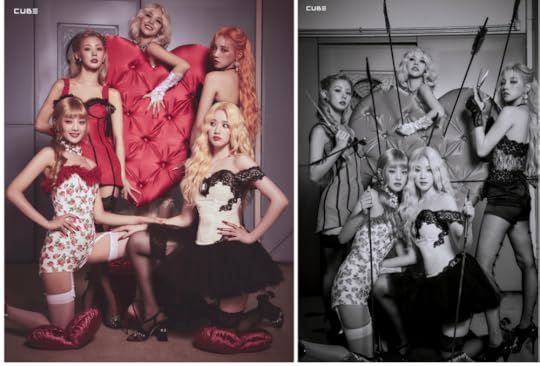
(G)I-DLE. “Nxde” Concept Photos (Source: Cube Entertainment)
Henry:
During my recent trip to Shanghai, I was introduced -- by Lenore -- to the music videos of [G]I-DLE and taken by the ways they seem to echo the themes and some of the style I associated with Madonna videos from the 1980s and 1990s and that some of my students here have compared to the Gwen Stefani videos of the early 2000s. I was struck by the quality of discussions they were generating among the young women of Lenore's generation in China and the ways they functioned as vehicles for popular feminist concepts from South Korea to enter into the conversations about gender in urban China. In my investigations since, I have learned that [G]I-DLE is technically considered part of the "Girl Crush" movement in K-Pop. So, I invited Lenore to join us for a conversation with Donna, who is one of my former students, who is Korean and does work on, among other things, Korean feminist and popular culture. These developments are not as well known in the west as they should be. I was hoping, Donna, you could give us a bit of a big picture of what this movement is about, how [G}I-DLE fits into it, and how these videos are being understood at the point of their production in Korea. Since many readers will not necessarily know these groups, this context may help everyone to better understand the discussions which follow.
Donna:
Let me zoom out from (G)I-DLE. Perhaps a bigger picture on the “Girl Crush” trend would help. This will inevitably be long. Many female K-pop idol groups have been successful in the 2020s, from newly debuted ones (aka “fourth generation” idols) to those who returned after a hiatus. Many of their lyrics focus on topics such as being a strong woman, self-confidence, and self-love rather than those that innocently seek love from (supposedly) male listeners. In other words, they are “me”-focused rather than “you (traditionally male listeners)”-focused. For instance, (G)I-DLE sings in TOMBOY (2022):
“Do you want a blond Barbie doll? / It's not here, I'm not a doll (like this if you can)….Your mom raised you as a prince / But this is queendom, right?”
IVE’s Love Dive (2022) parades great admiration for themselves, drawing on the Narcissus mythology. All translations are by me:
“Narcissistic, my god I love it / 서로를 비춘 밤 [the night that we shone on each other] / 아름다운 까만 눈빛더 빠져 깊이 [beautiful black eyes fall more deeper] / (넌 내게로 난 네게로) [(you into me I into you)] / 숨 참고love dive [hold breath love dive]”
LE SSERAFIM emphasizes their agency and passion for their career in ANTIFRAGILE (2022):
“무시 마 내가 걸어온 커리어 [don’t overlook my career path] / I go to ride till I die die .... 멋대로 정하네 나란 애에 대해 [decides however they want the person I am] / I don’t know what to say I can’t feel it / 뜨거운 관심은 환영 귀여운 질투는 go ahead [fervent attention welcome cute jealousy go ahead] / 줄 달린 인형은 no thanks 내 미랠 쓸 나의 노래 [string puppet no thanks my song that will write my future] / Yes gimme that”
LE SSERAFFIM - “Antifragile”. (Source: YouTube)
Beyond K-pop, female talents’ careers and “strong,” “independent” women personae are becoming more recognized and celebrated in the broader South Korean media industry. Kim Sook, has gained nicknames like “Sook-crush (drawing on “Girl Crush”),” “Furiosook (parody of Mad Max’s Furiosa)” and “Matriarch-sook” from her famous gender role-flipped humor and non-subservient image that she built over ~25 years of her career, became the second woman to ever win Korea’s national broadcasting station’s (KBS) Grand Prize in Entertainment in 2020 since Lee Young-ja’s first win in 2018. Female street dancer crew reality competition series Street Women Fighter (Mnet; 2021-2023) and many of the featured dancers have become sensational hits. As the series’ name suggests, the “Girl Crush” dancers boasted “strong” physiques, personalities, and styles but with comradery and professionalism that matched their (formerly underrecognized) diverse and impressive career backgrounds, rather than one-dimensional “catty” competitiveness.

Kim Sook’s “matriarch” comedy. Caption: “The best man is a man who carefully and gently does housework.” (Source: YouTube)
An example of a more explicit crossover with K-pop would be Refund Sisters, a temporary project group from TV variety show “Hangout with Yoo” (MBC) that consisted of four top female pop divas across generations of K-pop Uhm Jung-hwa (1993 debut), Lee Hyori (1998 debut; first generation idol group Fin.K.L member who became a national icon after solo debut in 2003), Jessi (2005 debut; amassed great popularity from Mnet’s 2015 female rapper competition show “Unpretty Rapstar”), and Hwasa (2014 debut; third generation idol group Mamamoo member). The group name originates from the joke that advocating for oneself (e.g., asking for tricky refunds) would be easy with the support of its fierce, confident members. Their single DON’T TOUCH ME (2020) celebrates their successful careers as “strong” women in K-pop:
“Trouble 이래 다 그래 [everyone says I’m trouble] / 세 보인대 어쩔래 [says I look strong so what] … 불편한말들이 또 선을 넘어 [uncomfortable words cross the line again] / 난 또 보란 듯 해내서 보여줘 버려 [as if to show off I accomplish again and show off] / 나도 사랑을 원해 [I want love too] / 나도 평화가 편해 [peace is easy for me too] / 하지만 모두가 you know [but everyone you know] / 자꾸 건드리네 don’t touch me [they bother me don’t touch me] … I don’t care yeah yeah / 내 맘대로 해 [I do as I please]”
Refund Sisters - Don’t Touch me. (Source: YouTube)
As the group composition of Refund Sister and their respective debut year suggests, the presence of “strong,” “Girl Crush” women figures in K-pop is not new (e.g., BoA - Girls on Top (2005); 90’s “strong unnies”). “Sexy female warrior” had been a historical trope that served as an alternative to the cute, innocent, and “girlish” presentation. The same goes for K-pop idols. A step more advanced from “sexy female warrior,” second-generation idol group 2NE1 (2009-2016) was considered groundbreaking during the era with their independent, less male gaze-centric self-presentation. With members at the time who were perceived as less conventionally beautiful (cf., their song Ugly (2011) captures internalized gendered lookism in Korea), 2NE1 confidently sang in studded outfits and experimental hairstyles.
“Ha-ha-ha-ha 다신 널 비웃지 못하도록 [Ha-ha-ha-ha so that they can’t laugh at you anymore] / Now let’s 춤을, 춤을, 춤을 춰요, want to get down [Now let’s dance, dance, dance, want to get down] / 보다 큰 꿈을, 꿈을, 꿈을 꿔 세상은 [dream bigger dream, dream, dream, the world] / 내 맘대로 다 할 수 있기에 큰 자유를 위해[I can do whatever I want for great freedom]” (debut single FIRE, 2010)
Arguably, their songs still tended to be thematically centered around heterosexual romantic love and pursuit. Their global hit I Am the Best (2011) is literally about how they are the best and they feel great being so with many repetitions of the song’s title. However, even this song includes a part where they claim that men take a second look at them and women try to imitate them, after which they mock (contextually presumably male) posers (“playa’”) whose pursuit they reject. Moreover, it should be noted that 2NE1 was considered unconventional. The following are some examples of lyrics from popular second-generation K-pop girl idol groups.
“Hey, 오빠 나 좀 봐 [Hey, oppa (term for older brother and older male acquaintance of similar age range) look at me / 나를 좀 바라봐 [please look at me] … Oh, oh, oh, oh, 빠를 사랑해 [Oh, oh, oh, oh-ppa I love you] / Ah, ah, ah, ah, 많이 많이 해 [Ah, ah, ah, ah, lots and lots] … 오빠 오빠, I’ll be, I’ll be down, down, down, down [oppa oppa, I’ll be, I’ll be down, down, down, down].” - Oh! (2010) by Girls’ Generation
“Tell me, tell me, tell, tell, tell, tell, tell, tell me / 나를 사랑한다고, 날 기다려 왔다고 [that you love me, that you’ve been waiting for me] / Tell me, tell me, tell, tell, tell, tell, tell, tell me / 내가 필요하다 말해, 말해줘요[say that you need me, tell me]” – Tell me (2007) by Wonder Girls
2NE1 - I am the Best (Source: YouTube)
Girls’ Generation - Don’t Touch me. (Source: YouTube)
So yes, I believe it would be appropriate to approach the current trend of idol K-pop as more in the direction of “Girl Crush.” Their overall presentations have been interpreted as targeting “auntie fans” over “uncle fans” (Korean article). Even New Jeans, a fourth-generation girl idol group that does not really have a “strong women” type of presentation, is being interpreted as a youthful group that reminds fans of their innocent teenage years. I think this trend both reflects the rise of feminism in S. Korea (and globally) and the industry’s recognition of these fans’ purchasing power. There is an ongoing social hostility towards feminism in Korea but the current trend in K-pop can be interpreted as the desires for gender equality and diverse role models being more recognized (e.g., Kim Sook’s winning of KBS’s 2020 Grand Prize in Entertainment), albeit possibly in the form of---and supported by the language of---(profitable) “demand.”
Perhaps another factor that allows the creative freedom for this direction would be the emphasis on worldbuilding in fourth-generation K-pop idols. This too isn’t “new” per se as many pre-fourth generation idol groups had historically crafted their own fantasy world to base their group production and storytelling. This also does not apply to all groups. In fact, New Jeans does not draw on fantasy, and (G)I-DLE does not have a set “concept” world as their background. However, many fourth-generation K-pop idols have been more explicitly invested in building a larger interconnected story world and creating songs in accordance with their group’s narrative, with each release being a part of the larger storyline that is to be unraveled, also open to fan participation. Most notably, with Aespa’s debut, SM Entertainment has been weaving together their previous idols’ narratives under their version of the Marvel multiverse, “SM Culture Universe.” If an idol group’s central narrative task revolves around navigating the vast, mysterious “Kwangya (translates to the wilderness)” and fighting “Black Mamba,” seeking oppa’s love is not so important. Similarly, declaring that they are “antifragile” in the fantasy world of Crimson Heart (webcomic version of the group LE SERRAFIM’s worldbuilding) as a character is more risk averse and ambiguous than declaring so against the Korean society’s structural gender inequality as a Korean woman.
Aespa - Black Mamba (Source: YouTube)
This is by no means a comprehensive history of “Girl Crush” movement in K-pop. But I hope this will be helpful for those who are not familiar with Korean entertainment media. A couple of things that may be specifically unique about (G)I-DLE could be that their leader Jeon So-yeon has been directing the course of the group’s activities including overall album production instead of simply performing the songs and that unlike many other fourth-generation idol groups they do not have a structured “concept” fantasy world that they are drawing their inspiration from. My knowledge about the group is not extensive; I would love to hear your thoughts on (G)I-DLE or any other groups that are relevant to this topic, perhaps regarding how global fans are interacting with their content.
Lenore:
Luckily, the K-pop group and TV shows you mentioned in the last letter are also well-known in China. In my following response, I will discuss what may be ‘Girl Crush’ from my own experience and fan practice about it. In my opinion. ‘Girl Crush’ may not just be about the image of a ‘strong female’, but also the spirit and power the idol brings to fans that make them want to follow and even fight against some inequality in society.
When I tried to recall the starting point of the K-pop ‘girl crush’ style that appeared in China, 2NE1 came to my mind too. It was in 2011, 2NE1’s ‘I AM THE BEST’ suddenly became the background music of most of the stores, almost everyone knew how to sing the song even if we didn’t know the meaning of the lyrics. Girl’s Generation’s ‘GEE’, at the same time, was well known for its catchy lyrics and was popular among the young generation. Though both of them were very popular, students took different attitudes to ‘GEE’ and ‘I AM THE BEST’: boys treat the former in a teased attitude, they perform the song to attract other’s attention and hope to see girls perform it in cute style and then mock at them, which leads to girl’s rejection and uncomfortable feeling. Though we didn’t know what ‘male gaze’ was at that time, we knew the meaning behind its popularity among boys and tried to avoid such a situation. The appearance of 2NE1’s ‘I AM THE BEST’ appropriately fits girl’s attitude and dream—we don’t want to be ‘cute’ as they think we should be, we want to be cool and have some ways to show we are. So, though we loved both of them, the latter were performed more frequently by girls. In this stage,’ wanna be cool’ was our core goal to follow the K-pop ‘girl crush’ group.
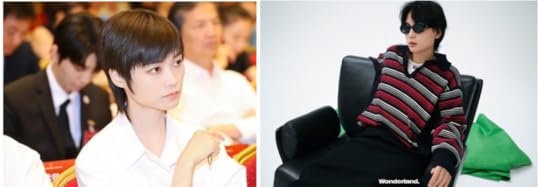
Chris Lee(Left), BiBi Zhou(Right). Source: Sina Weibo
At the same time in China, BiBi Zhou and Chris Lee are also two popular singers among teenagers (especially girls), both of them are girls but have a neutral appearance and singing style. They are ’Tomboy’ in our parent's mouths, and some parents don’t want their baby girls to pay too much attention to them because they look ’neither male nor female’. Their love songs break through the traditional framework, it did not depict a ‘poor girl who is waiting for her lover’s attention’ anymore, but a teenager who wants to cherish love and time, which definitely aroused many teenagers’ resonance.
HyunA - 'Lip & Hip' (Source: YouTube)
Then HyunA Kim came to the stage center of Chinese K-pop fandom, with her sexy appearance and confident attitude. (I have asked many people whether they think HyunA belongs to the ‘Girl Crush’ category, and most of them said ’no’ but were convinced by me then, so it’s just my stubborn try here. She may arouse some controversy and I would like to hear your views about her.) HyunA is worth discussing, she has more female fans than male fans in China, and there is a rumor that says ’HyunA is a woman who owns overly aggressive beauty, she won’t be welcomed by men here.’ But that is the reason why she was welcomed by female fans, the idea she conveyed to us was ‘Do not feel shy to show your sexyness and beauty.’ These ideas are very important in our society. For a long time, girls tried to hide themselves and look well-behaved, those who wore short jeans and shirts may be criticized by their parents or even be verbally abused as ’slut’ by strangers. Sexy appearance may be a curse at that time. In school, some girls bend their backs to try to make their bosoms not so evident, they lack confidence because of the strange eyes of the environment though it’s physically normal. So HyunA’s sexy confidence influences many of them and creates an image of what they want to be in the future. What is more, though HyunA sings love songs too, some of her songs build a ‘queen’ image. For example, in HyunA’s Lip & Hip (2017), the lyric says (I translated it from Chinese lyrics so it may have some mistakes)
‘ 오늘 내가 Queen queen queen / 내 옆에만 서면 너도 King king king / 날 원하는 남자는 많지만 너를Pick pi pi pi pi pick / 매일 난 솔직하게 표현해 주길 원해 / 마치 네가 네가 아닌 것 같아 / 가끔 난 섹시하게 워킹은 더 당당해 난‘
' Today I am the queen / If you stand by my side you are also the King / There are plenty of men who want me but I pick you / Every day I want it to be honest (to express myself) / Sometimes I need to show my sexy and should be more confident '
Compared with traditional songs, HyunA puts women’s positions higher than men, which reverses the power position in old love songs. So, her ‘sexy’ here may be ‘overly aggressive’ to men, but her uncovered ambition builds a model for girls and encourages them to present themselves. So, the definition of ‘Girl Crush’ here may not depend on whether it is desexualization or not, it depends on the idol's attitude and girls’ feedback about ‘If I should follow her or If she gives me some courage in some aspects’.
蔡依林 Jolin Tsai - PLAY我呸 (Source: YouTube)
Another thing worth mentioning here is that some fans in China remix HyunA's ‘How This ' and Jolin Tsai's ‘Play ’, the remix of them makes the songs more aggressive (to men) because the song conveys a thought like ‘I don’t care about who you are, you are just my prey and toy’. Jolin Tsai is also a ‘queen’ in China. Since the release of her album ‘Myself’ (2010), she highlights and conveys the spirit ‘you should be confident and independent, your yellow skin color is beautiful’. So, the remix of two queens' songs shows the attitude of the fans toward both of them.
Moonbyul - Love & Hate (Source: YouTube)
Moon Byul E (Moon) in Mamamoo is also a representative idol in ‘Girl Crush’ topic. She shows both confidence and a unique charm to the fandom. We call her ’live spanner’ because the spanner could turn the ‘straight' to other shapes, and Moon could let girls love her and imagine her as their girlfriend. In her solo song ‘Love & Hate’(2017), she wears black suit and does the same dance with male partners, which makes her look cool and somehow have a feeling of 'soft masculinity’. Fans also show their love for her voice and temperament in the comment section of the song, I took some sentences from Love & Hate’s Youtube comment section:
‘ Moonbyul is living proof that a woman doesn't need to show skin to be sexy and hot! Love you girl! ‘ (@louisacasella3059)
‘ Every single person in Mamamoo is so talented and have amazing vocals. But Moonbyul's low vocals is something I've never heard among female idol vocalists. It's so unique and I wish she'd get to sing more like in Paint Me. I absolutely adore her voice and Taehyung's voices cause they have alto and baritone vocal ranges respectively in an industry dominated by sopranos and tenors. ‘ (@anishasrikar4996)
So Moon’s ‘Girl Crush’ here is not only 2NE1 and HyunA’s ‘I wanna be like her’, but also a real attraction to girls. I may want to highlight her 'soft masculinity’ here because I was a fan of both Mamamoo and Arashi(Jpop group) at that time. As a Jpop male group, Arashi did not stress idol’s masculinity but wanted male idols to perform femininity to attract female fans, and it worked—the group became one of the most famous idol groups in Asia, and their album '5×20 All the BEST!! 1999-2019’ have won the 'Global Top Album’ award in 2019. (They even exceed Taylor’s ‘Lover’ and BTS’s ‘Map of the Soul’ in this list). Matsumoto Jun in Arashi was called ‘men like flower’ by fans to show his beauty. In Arashi’s success, I have found that women may be more willing to access performers who have femininity than those who have masculinity like Chris Hemsworth, but the paradox here is that though fans love femininity, they also need the reliability provided by masculinity. What may make them win in this step may be the balance of masculinity and femininity, not their physical gender. But when it comes to physical gender, it is obvious that a woman could arouse more empathy and provide more sense of safety than man to fans. So that may be one winning point of ‘Girl Crush’ when compared to those real men who also have 'soft masculinity’, female performers provide reliability and empathy that only belong to the same gender and situation.
(G)I-DLE - 'TOMBOY' (Source: YouTube)
Empathy and resonance are important to ‘Girl Crush’ since we have talked about the importance of ‘wanna be’ and ‘equality between male and female audiences’ relationship’ in it, but just having the same gender is not enough. As a way to rebel against the imbalance and strange eyes of society, girls need an obvious expression that fits their ideas, which is the best part of (G)-Idle. In (G)-Idle’s song, they talked about body anxiety (Allergy,2023), fighting back to the male gaze (Nxde,2022), and trying to break the stereotype of Tomboy and femininity (Tomboy,2022). In their song ‘I want that’, they discuss domestic violence through their performance in MV. We can see that they are not only cool and confident in their appearance but try to use such ways to discuss the inequality in reality, which draws fan’s attention and arouses their resonance. After the release of ’Nxde’, lots of girls (even not fans) use the lyric ‘I‘m born nude, you’ve got a dirty mind’ to fight back against the strange eyes and verbal bullying. So, the expression and the power they express in the song gives those girls the power to say something instead of feeling shy/pretending they are cool/hiding their interests like they used to do before.
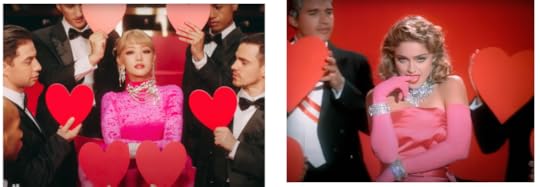
(G)I-DLE) - 'Nxde' (LEFT), Madonna - Material Girl (RIGHT)
Another interesting thing about (G)-Idle is their performance in MV, they pay tribute to many famous antecedents and use some bold narrative means to express themselves and tell the stories. In ‘Nxde’,Jeon So-yeon, minnie and Shuhua dress the same clothes as Madonna in ‘Vogue’ and ‘Material Girl’. From Tomboy’s killing a Ken to I Want That’s killing a real men, their rebellions are increasingly obvert. So, I am wondering if K-pop had such direct rebellion before to any societal problem, whether such storytelling form is a traditional expression form or a new form starting from K-pop feminism.
NewJeans 'Ditto' (Source: YouTube )
New Jeans is also a special group in this topic, as you said, they have more ‘aunt fans’ than ‘uncle fans’. In the Chinese context, they may not only be a memory of youth, but also a dream and compensation of it. When they first entered our market, they were labeled as “American high school style," which indicates that the youth they represent is culturally different to us. Most of Chinese students are not allowed to touch cosmetics or fall in love with others before they enter the university. All we should do at that time is to chase a good school performance. Expressing your feelings or fantasies sometimes may bring shame, but the appearance of NewJeans tells us it is normal and your emotion should be well taken care of by your sisters: NewJeans.Even though fans have grown up, they still need such comfort and make up their youth through something that could be seen, imitated, or shown.So in ‘Ditto’, they set up a 'me', who is not anyone in the group, but a high school girl with real emotions, as if the fans were participating in the youth they created for us through the character (like the main female character in the otome game, or maybe we could call it a parasocial relationship). They could be ‘Girl Crush’ too because they create a youth image girls(women) want to be even if they cannot trace back to time and fulfill this dream. The group convey the spirit through their energetic expression and fill the holes in some women’s hearts.
So I have depicted a picture of ‘Girl Crush’ K-pop group in China and try to tell what girls learn from them: from silent avoidance to protesting loudly, from hiding themselves to showing confidently, from a poor girl waiting for love to a queen control the right to choose, it is not only the image transfer on the media, but also some attitudes change in women in the real world. ‘Girl Cursh’ here, is not only ‘ wanna be her ‘, but a channel to gain power and express your attitude. We may don’t need to be a strong woman or pretend to be cool, we could fall in love with others like New Jean’s interpretation of ‘Ditto’, we could show our sexy like HyunA, and we could be what we want to be through the channel.
BiographiesDo Own (Donna) Kim is an Assistant Professor at the University of Illinois Chicago's Department of Communication. She studies everyday, playful digital cultures and mediated social interactions. She focuses on boundary-crossing practices in human-technology assemblages: being together across diverse "real", "online", "virtual", or "imaginary" places, and among the mundane and the weird, the "normal" and the Other. What does it mean to be human in mediated communication environments? How do we want to be together?She received my Ph.D. degree in Communication from the University of Southern California's Annenberg School for Communication and Journalism (2022). Her dissertation—Virtually Human? Negotiation of (Non)Humanness and Agency in the Sociotechnical Assemblage of Virtual Influencers—took a deep dive into boundary crossings in digital reality technology and social media cultures through the lens of virtual influencers (CGI human social media influencers).
Ying Wang (Lenore) is a second-year master’s student in Journalism and Communication at Shanghai University. As a participant in various popular cultures, she explores cosplay, games and online fiction. Her research focuses on participatory culture, especially gender and sexuality in fandom in China.
Henry Jenkins is the Provost Professor of Communication, Journalism, Cinematic Arts and Education at the University of Southern California. He arrived at USC in Fall 2009 after spending more than a decade as the Director of the MIT Comparative Media Studies Program and the Peter de Florez Professor of Humanities. He is the author and/or editor of twenty books on various aspects of media and popular culture, including Textual Poachers: Television Fans and Participatory Culture, Hop on Pop: The Politics and Pleasures of Popular Culture, From Barbie to Mortal Kombat: Gender and Computer Games, Convergence Culture: Where Old and New Media Collide, Spreadable Media: Creating Meaning and Value in a Networked Culture, and By Any Media Necessary: The New Youth Activism. His most recent books are Participatory Culture: Interviews (based on material originally published on this blog), Popular Culture and the Civic Imagination: Case Studies of Creative Social Change, and Comics and Stuff. He is currently writing a book on changes in children’s culture and media during the post-World War II era. He has written for Technology Review, Computer Games, Salon, and The Huffington Post.
March 11, 2024
OSCAR WATCH 2024 — Video Essay Reflections on Character in ‘Oppenheimer’ (2023)
This post is part of a series of critical responses to the films nominated for Best Picture at the 96th Academy Awards.
This post features two video essays responding to the 96th Academy Award Best Picture winning film Oppenheimer (2023): Kai after Kai’s “The Guilt of Oppenheimer” and Ella Wright’s “Fission, Fusion, and Character in Oppenheimer.” I encourage you to pay particular attention to the sound in each piece, the careful dichotomies between loudness and silence in “Fission, Fusion, and Character in Oppenheimer” and the menacing yet also space age-y melodies of Kai after Kai’s original music in “The Guilt of Oppenheimer.” Both essays use sound to reinforce their critical points, rather than simply to ground their audiovisual timelines.
“The Guilt of Oppenheimer” by Kai After Kai“The Guilt of Oppenheimer” is a powerful mediation on the morality of both the historical Oppenheimer’s actions and director Christopher Nolan’s framing of Oppenheimer’s story. It places Oppenheimer as perhaps the paradigmatic brilliant asshole, whose genius supposedly allows him (and it’s always a him) to mistreat the people around him and yet still somehow garner sympathy when he feels bad about what he’s done. But while such characters are often fan favorites, Kai after Kai asks us to consider the real damage they do on both interpersonal and geopolitical planes.
“Fission, Fusion, and Character in Oppenheimer” by Ella Wright“Fission, Fusion, and Character in Oppenheimer” uses the metaphors of fission (Oppenheimer) and Fusion (Strauss) to characterize what we might call the protagonist and antagonist of the film. While Oppenheimer continually struggles to reconcile morality with science/politics, Strauss is completely immersed in his obsession with Oppenheimer. Neither of them find joy or comfort in their atomic metaphor, and, as the ending suggests with its invocation of the continually escalating dispersal of ever-more deadly nuclear weapons, perhaps they don’t deserve to.
If you’re not familiar with the world of video essays and videographic criticism, I hope these two pieces piqued your interest! You can continue on to Kai after Kai and Ella’s channels to see more of their work. There is a lively and sophisticated field developing between the academy (such as the SCMS Digital Humanities and Videographic Criticism Scholarly Interest Group) and popular intellectual creators (such as the essayist community The Essay Library) that we hope to feature more on this blog.
BiographiesI'm Kai After Kai (A.K.A James Makepeace), a video essayist, actor, music artist and overthinker. I make videos about whatever I happen to find interesting at that particular moment, be it film, music, anime, games or just general philosophy, often companied by my own ambient, electronic compositions. I'm currently working on an album, a short film and a variety of intermittent videos.
Ella Wright is a doctoral candidate at the University of Birmingham, undertaking an audio-visual PhD. Their research explores what is termed as ‘the video essay’, face to face with notions of embodiment, materiality, logocentrism and epistemology regarding video making research-by-practice. Ella is also a documentary filmmaker and editor, having recently completed editorial work on their first feature length film ‘Children of the Wicker Man’, directed by Justin Hardy, and directorial work on a documentary short 'Pushing the Boundary', examining the inclusion of people with learning disabilites in the workplace.
Samantha Close earned her PhD in Communication at the University of Southern California. Her research interests include digital media, theory-practice, fan studies, gender, race, and Japanese media. She focuses particularly on labor and transforming models of creative industries and capitalism. Her documentary, I Am Handmade: Crafting in the Age of Computers, based on her most recent research project, is hosted online by Vice Media’s Motherboard channel. Her writing appears in edited volumes and academic journals, such as Feminist Media Studies, Transformative Works and Cultures and Anthropology Now.
March 10, 2024
OSCAR WATCH 2024 — Feminist Frankensteins
This post is part of a series of critical responses to the films nominated for Best Picture at the 96th Academy Awards.
This is a dialogic piece between Henry Jenkins and Kris Longfield that explores the three recent feminist re-tellings of Mary Shelley's Frankenstein: Lisa Frankenstein (2024), The Angry Black Girl and Her Monster (2023), and Oscar-nominated Poor Things (2023).
Henry Jenkins:
I saw and enjoyed Lisa Frankenstein recently, which is the third feminist retelling of the Frankenstein myth I've seen in the past six months. In one (The Angry Black Girl and Her Monster), the woman is the mad scientist. In the second (Poor Things), she's the monster. And in Lisa Frankenstein, one could argue that she's "the Bride." As we prepare for an Oscars where Poor Things looks to be a major contender for several top awards, most decisively Best Actress where Emma Stone is in contention with Lily Gladstone (Killers of the Flower Moon), I thought it would be interesting to explore how each of these works re-storied the Frankenstein myth and why. This discussion started on Facebook, where I posed the question of what it meant that we were seeing so many female-centric versions in recent months—with at least one more in the works as Maggie Gyllenhaal is currently directing her own version of Bride of Frankenstein and Guillermo del Toro also doing his own distinctive take.

poor things (2023)
If we go back to the source material, Frankenstein was written by Mary Wollstonecraft Shelley, who has been celebrated in recent years as herself a proto-feminist writer. Shelly had suffered a miscarriage some months before she began to write the novel. She describes the monster at one point as an “abortion.” Many now think she wrote the novel in response to the harsh and indifferent treatment she received over the loss of her baby from her husband, Percy, and his close friend, Lord Byron. Shelly scholar Anne K. Mellor describes it as a story “about what happens when a man tries to have a baby without a woman ... [Frankenstein] is profoundly concerned with natural as opposed to unnatural modes of production and reproduction.” Such a reading sees the story as centrally about the homosocial relationship between men – Dr. Frankenstein, his monster, and his various professors and assistants who imagined a “bold new world” where men could create life. What was monstrous was not the creature, whose innocence did not prepare him for the world, but the doctor, who abandons him with indifference almost as soon as he is brought into the world. Godwin Baxter in Poor Thingsis a more caring father who only reluctantly allows his creature to go out in the world.

bride of frankenstein (1935)
There’s so much that can be said about the campy queerness in James Whale’s Bride of Frankenstein. Elsa Lancaster is both the bride and the author in the film, and some have argued that the title refers to Elizabeth, the newly married wife of Victor, rather than the monster’s mate, who only appears in the film’s closing moments. Whale, though, mirrors an early scene with Percy and Lord Byron on either side of Mary Shelley with a later one where Victor and Dr. Septimus Pretorius hold hands with the Monster’s Mate in a similar fashion, further suggesting the collapsing of the two roles. Paul Morissey’s Flesh of Frankenstein and Kenneth Branaugh’s version, Mary Shelley’s Frankenstein, both lean heavily into homoerotic imagery in depicting the “unnatural act” of creating the monster. And, of course, there’s The Rocky Horror Picture Show, where the role of the mad scientist is assumed by Tim Curry’s Frank-N-Furter, the “sweet transvestite,” who seems to queer everyone he encounters.
By centering women in these traditionally male roles, these newer Frankenstein films ask different kinds of questions, renewing the story by mapping alternative meanings onto its core figures. So far, I am seeing debates about gender, sexuality, and Poor Things which ignore the other films. When I raised the question on Facebook, Kris Longfield had some rich suggestions, so I asked her to join me for this dialogic post.
Kris Longfield:
Svengoolie just aired its Bride of Frankenstein episode this past Saturday, so Bride’s fresh in my mind again. It has some very weird resonance today, as it comes with a strong sense of coercive control - Dr. Frankenstein is forced to create the Bride at the behest of Dr. Pretorius and the Monster, due to Elizabeth having been kidnapped, with the strong suggestion that a female monster would solve the problem of the Monster’s loneliness, as she would be a natural mate for him. Instead, her rejection and fear of him makes the Monster even more frustrated and alone, leading to his choice to destroy the lab with himself, the Bride, and Dr. Pretorius inside. There are shades of incel in the entitlement to a mate.
All three films, Lisa Frankenstein, Poor Things, and The Angry Black Girl and Her Monster, take on different things to fix, but the question always centers on the idea of “what are we taking from the past and what are we taking from the present” in how we’re trying to solve problems (with a look at how female agency factors in).
Lisa Frankenstein is sewing specific modern body parts onto her chivalrous undead boyfriend; Poor Things plops a baby’s brain into a grown woman’s body; and Vicaria, in The Angry Black Girl and Her Monster, discovers that raising the long dead isn’t an issue, but the recent dead are a different matter.

lisa frankenstein (2024)
Lisa Frankenstein approaches the issue of a monster and his mate from the opposite direction. While he initially shows up and chases her around her house, he is a kind of sad and broken figure that she adopts as a friend and works a kind of nurturing magic on. Despite (quoting her stepsister) to say that “it’s a waste of time to fix a boy, it’s better just to accept a guy’s flaws,” she plays mad scientist herself - sewing her stepmother’s ear on him, luring her creepy lab partner so they can chop off his hand to attach, and finally, sewing on her crush’s genitals. It’s a very feminized version of a mad scientist, leveraging her sewing skills and the electrocution in her sister’s tanning bed, but the parts feel like they have symbolic resonance. While Lisa starts with the resurrected but damaged body of a chivalrous man from the past, she adds a woman’s ear, and the story then depicts a relationship that includes a lot of listening from him. While her lab partner felt her up nonconsensually, she’s very clear about promising to hold his hand (which she later does, albeit aloft), and this previews a turn in the story where Lisa and the monster have a greater sense of equality and being on the same level. And then the relationship can only be consummated once she’s sewn on modern genitals.
It’s interesting to me that once she’s able to consummate the relationship, she decides that due to the various people they’ve killed, she needs to die. The atrocities she’s committed in fixing him now make it impossible for her to remain without consequences. After her death, the monster, having fully recovered and being able to speak again, resurrects her as his Bride. So, in a sense, both have played mad scientist to the other.
It’s weirdly romantic, this idea that we don’t simply find a mate, we make them. No one starts as a perfect match. At the same time, the story’s also clear that Lisa’s ideal man only has a few modern male qualities (let’s sum them up as egalitarianism and sexuality), and she’s entirely grafted on the idea that he might listen to her the way a female friend would.
Poor Things also provides Bella the opportunity to play the mad scientist with one of the male characters, her abusive husband/father, whose life she saves after he shoots himself in the foot. However, she also switches his brain with that of a goat to minimize the harm he can do to her. Her outlook is much closer to the idea that one can’t fix someone but also that she shouldn’t have to. The men who are good or bad or ambivalent simply are the way they are; she has no ability to fix them, as Lisa Frankenstein does.
This is a conclusion that she comes to over the course of the story, after being an experiment herself, and, in turn, experimenting on everyone around her. At the end, a fully realized Bella decides that she wants to become a mad scientist like her creator/father. That’s her happy ending.
Both of these Brides are also mad scientists, a weird mix of naivete, trauma, and artistry.
But this idea, relatively unexplored in Bride, that not being able to control or predict the female monster is the reason to bring the lab down around one’s ears, (when the same is true of the male monster) is where I would start in looking at Poor Things. A lack of control and unmet expectations is where the story of Poor Thingsstarts to go off the rails for Bella’s paramour, Duncan Wedderburn. He believes himself in control and takes advantage of Bella’s naivete in a villainous way. But when she begins to explore on her own, to eat what she wants, to have sex with who she wants, to dance when she wants - especially without regard to the propriety Duncan’s been socialized into expecting, he begins to see something villainous and evil in her. He tries to fix the situation by isolating her on the boat with him, only for her to give away his gambling winnings, forcing them back ashore. He expects her to put his needs and desires first, which she never does. It makes him both oddly attached to her - he can never be satisfied until she, specifically, fulfills his needs - but it’s also what drives him into an asylum, because she never will. There is something specific about a female monster that is very focused on romantic control.
Skipping back to Lisa Frankenstein for a moment - the happy ending there is very much created by her “Bride” version being reunited with the male monster at the end. And, in shades of the original Bride, she is the one who pulls the “lab” down around her own ears, demanding he set the tanning bed to “max bronze.” She’s become a monster of her own making, via the murders she participated in.
Bella, by contrast, is definitely created against her will to some degree but mostly in the sense that every baby is. When Godwin is asked why he wouldn’t reanimate her mother’s body with her mother’s brain, he has an odd respect for her mother’s autonomy and choice to die. He continues this respect for Bella’s autonomy, letting her make her own choices (though he does make the suggestion to McCandles to marry her, McCandles still has to ask Bella herself). Ultimately, Bella’s story comes full circle when she decides to become a doctor and make her own mutant experiments. Following in Godwin’s footsteps is a choice made of her own understanding and autonomy.
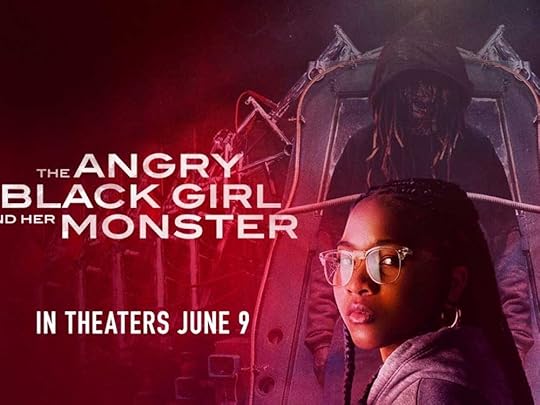
the angry black girl and her monster (2023)
Vicaria’s story in Angry Black Girl carries the sense of autonomy even further because, at every step, she must fight for her choices. Her choices are continually critiqued in a way that the original Dr. Frankenstein isn’t subject to as a white, wealthy man. But this ultimately sets her up to push past the failure of her monster. She has less to lose and more training to resist the influence of others: this is why she’s ultimately successful.

famous monsters of filmland
Henry Jenkins:
I am intrigued by your reading of The Bride of Frankenstein as an incel narrative, though I am not sure I totally agree with it. As a child of the 1960s, who grew up reading Forest K. Ackerman’s Famous Monsters of Filmland magazine, I was taught to understand the monsters in the Universal films as tragic figures, shaped by conditions not of their own making, and who were frequently social outcasts. Nowhere was this more true than Ackerman’s pretty convincing take on Frankenstein’s monster, who would seem to have much in common with Casper the Friendly Ghost. He seeks to make friends everywhere he goes, but his appearance produces only dread and horror and, in some cases, he doesn’t understand human ways. He picks flowers with a young girl, tossing them into the water, and ends up drowning her. He meets an old blind hermit in the woods (in Bride) who befriends him until others intrude and chase him away. And even the Bride he has made for him to be his “friend” – it’s not clear that sex was ever what was sought by him given his seeming “innocence” of adult sexuality – rejects him, and it is then that he does what any self-respecting emo might do and seeks death over further pain.

the last repair shop (2023)
We might see the other male characters in the film in similar ways – Dr. Frankenstein is kicked out of college for being too smart, exploring forbidden knowledge, and Dr. Pretorious seeks Frankenstein’s approval for his own accomplishments only to be rejected also. Bride of Frankenstein figures in yet another Oscar-nominated film – the documentary short subject The Last Repair Shop – the story of the men and women who repair broken musical instruments for the LA schools. The man who fixes the string instruments shares the story of discovering the pleasures of playing the violin when he sees the scene of the monster and the blind hermit in Bride. What he takes from this is not the moment where the monster is rejected but the moment of intense sociality between the men, the emotional satisfaction they both take from the music, which the monster follows through the wood and thereby finds shelter in the cabin.
Reading these characters as outcasts helps us to understand why two of the three contemporary films we are discussing here tap teen drama tropes. The Angry Black Girl is a BLERD, a poster child in some senses for STEM Education. She is shut down by her teachers and classmates as weird and uncomfortable because she asks too many questions and on the wrong subjects, just like Victor in the original film.
And Lisa is a very gothy outcast who has lost her mother, doesn’t gain acceptance in her new family, and can’t even be embraced by the other weird kids on the literary magazine. Diablo Cody – the creator of Juno, Jennifer’s Body, Lisa Frankenstein, and other such films – is too nuanced a scriptwriter not to complicate some of the generic categories into which her characters seemingly fall – giving more depth to the popular kid step-sister, for example, who seems to care about her new sibling even if she cares more about herself, giving some tragic qualities to the passive father who doesn’t seem to belong in the family he is creating for himself, and so forth. For sure, Lisa and her beau butcher people who have it coming, but Lisa’s outcast status is at least partially of her own creation.
Part of what gave the Universal monster films their sense of pathos was the nuanced performances which Boris Karloff and Lon Chaney Jr. brought to their roles. For all of his outsized qualities, Karloff plays the monster with a degree of gentleness and awkwardness. He does this even when he is acting with his eyes underneath a ton of makeup. And Lon Chaney Jr. as Lawrence Talbot in The Wolfman has a sense of sadness which he also carries with his eyes and his voice.
In Lisa Frankenstein, I was especially impressed by Henry Eikenberry as the 19th century guy whose resurrection makes him boy friend material. He clearly cares about Lisa from the first, even if, as you suggest here, he acquires a mix of 19th century and contemporary traits as the story advances. Again, he must initially act with his eyes and his hands, learning to speak across the film. So much of the comedy comes from his nonverbal reactions to Lisa shoving him into the closet, dressing him up, and mapping her emotions onto him, before finally learning to appreciate who he is rather than dismissing him for the high school hunk.
Emma Stone’s performance in Poor Things is a tour de force – no wonder she’s the front runner for Best Actress this year (even in the face of Lily Gladstone’s performance in Flowers of the Killer Moon and her historic status as the first Native woman nominated in this category). As an adult woman’s body animated with the spirit of a young child, she seems to lack any and all inhibitions. She jumps up on top of random visitors, she spits out her food in a polite restaurant, and, above all, she makes no attempt to cover her naked body or hide her sexual desire. She fits Freud’s description of the child as “polymorphously perverse.” As she develops more mature understanding, she rejects the pretenses of Victorian society and refuses to accept male limits on her pleasure. She doesn’t want to be controlled by men, for sure, and that’s what gives her a sense of agency, but as we see when she enters the brothel, she sees men, she understand what makes them tick, and, by this point in the story, she knows how to control them through giving them just enough of what they desire to get them to do what she wants.
If the original Frankenstein’s Monster seems a total outcast, she becomes popular in a circle of women who teach her what she needs to know to escape the control of men, and this sense of female solidarity is part of what makes this a feminist retelling. In a culture where women are often infantilized, her childlike innocence grants her the agency to disobey male rules, while she learns all she can from the women – libertines and whores for the most part – whose company she keeps.

bride of frankenstein
Else Lancaster’s performance in Bride of Frankenstein seems to be slowed down in comparison to the high levels of energy that Stone brings to the screen. She seems to be struggling to figure out what’s happening to her; she turns her head slowly and then shrieks when she sees the monster who is looking at her with such eagerness. She has had no time to adjust to her circumstances, no period of gradual intellectual development, and no mentorship from other women, all of which allow Bella to resist male control without being destroyed by them.
Kris Longfield:
I agree that the monster is more of a tragic outcast than what we might call an “incel,” and his overall innocence of the world is an excellent point. Bride is also sometimes read as having a metaphorical gay story at its center as well (two men make a baby). What’s most interesting to me is that the most successful relationship in the movie is actually the monster’s friendship with the blind hermit - there’s a specific sense of equality, as both are outcasts. This equality is arguably what the monster wishes he could recreate when the Bride is brought to life. But a key ingredient is missing - that of choice - the monster seeks the source of the violin music he hears, and the hermit is happy it led him to his door. If the monster had played an instrument, would he have fared better?

bride of frankenstein
Image 9
In Lisa Frankenstein, the answer is yes - Lisa and the monster bond over music, as Lisa first mentions having The Cure, which she then has to explain can only heal you emotionally. The monster also plays the piano for her once he gains a second hand, which continues to step up their emotional connection.
Image 10

poor things
Bella Baxter dances wildly to music during her development, but this exuberance is specifically discouraged by Wedderburn - this is when we start to see how strained their connection really is, because while he joins her in the dance, he is trying to rein her in rather than matching her energy. We see Bella continue to search for genuine connection through the brothel scenes, as when she instructs one man to tell her a childhood memory and then she tells a joke, before they begin. But the strongest connection she forges seems to have been her father, confronting him for the truth before he dies, and noting that the lab is where she feels she is at home. This is an inverse of Frankenstein, since Victor rejects the monster. So perhaps the real difference in the outcome is more related to attachment theory. Vicaria’s monster has a similar problem - if not double, as both Vicaria and his father ultimately reject the revived Chris, leading to further massacre.
To be a bit glib, my overall conclusion is that if only every outcast took up an instrument, we could avoid a lot of pain and suffering. It certainly seems to work on TikTok. But to be serious, if we look at why Frankenstein stories seem to be rising lately, maybe what it really comes down to is a society exploring who and what we have to be to find genuine connection with others. As a response to the epidemic of loneliness, do we need to bring a new person to life or do we need to listen for the sound of other outcasts?
Biographies
Kris Longfield is a partner and head of Research and Innovation at Fanthropology, where she combines anthropology, fan studies, focus groups and quantitative research to guide marketing and development for all the studios and streaming platforms in Hollywood. She’s worked on projects for major franchises like Star Wars, Star Trek, Marvel, DC, Jurassic World, Bond, Mission Impossible, Sonic the Hedgehog, and more; writes practical guides to genres and their audiences, studies the state of streaming, and published an industry guide on Building Universes in 2022, which she’s working on an update to in 2025.
Henry Jenkins is the Provost Professor of Communication, Journalism, Cinematic Arts and Education at the University of Southern California. He arrived at USC in Fall 2009 after spending more than a decade as the Director of the MIT Comparative Media Studies Program and the Peter de Florez Professor of Humanities. He is the author and/or editor of twenty books on various aspects of media and popular culture, including Textual Poachers: Television Fans and Participatory Culture, Hop on Pop: The Politics and Pleasures of Popular Culture, From Barbie to Mortal Kombat: Gender and Computer Games, Convergence Culture: Where Old and New Media Collide, Spreadable Media: Creating Meaning and Value in a Networked Culture, and By Any Media Necessary: The New Youth Activism. His most recent books are Participatory Culture: Interviews (based on material originally published on this blog), Popular Culture and the Civic Imagination: Case Studies of Creative Social Change, and Comics and Stuff. He is currently writing a book on changes in children’s culture and media during the post-World War II era. He has written for Technology Review, Computer Games, Salon, and The Huffington Post.
March 9, 2024
OSCAR WATCH 2024 — “Based on ‘Barbie’ by Mattel”: Adaptation, Franchising, and 'Barbie' (2023)
This post is part of a series of critical responses to the films nominated for Best Picture at the 96th Academy Awards.
Barbie is a cultural icon. Invented by Ruth Hadler and first released in 1959 by toy manufacturer Mattel, ‘Barbie’ is a fashion doll that has had transformative impact on how children tell stories through play. In this context, Barbie is culturally polysemic: “brim with multiple meanings capable of attracting multiple types of individuals” (Rogers 1999, 2). According to Mary F. Rogers in the book Barbie Culture, such cultural icons are paradoxical, whereby “icons become such because of their versatility, thick folds of meaning, adaptability to diverse individuals’ needs or interests, ultimate ambiguity, and open-ended nature” (1999, 2). This cultural multiplicity and ambiguity of Barbie, in tandem with its nature as a toy, provokes an interesting discussion about the adaptation status of the blockbuster movie, Barbie (2023). As director and co-writer Greta Gerwig reflects, “It’s an object…It’s a doll. There’s no character, no story. The very nature of Barbie is that it’s a toy to be projected onto” (Pond and Lopez 2023; original emphasis). This perceived lack of story or character suggests that Barbie is an original screenplay, but it is still based on a pre-existing intellectual property. As an opening title card reads, Barbie is “Based on ‘Barbie’ by Mattel” (Figure 1). Barbie is also a part of the ‘Barbie’ franchise, which means it has a material, industrial and historical story that works in concert with the polysemic, ambiguous and open nature of Barbie as a toy. Barbie is therefore shaped by the creative interpretation of Barbie as a culturally iconic toy and ‘Barbie’ as a franchise property owned by Mattel.

figure 1: opening title card in Barbie (2023)
The question of Barbie as adaptation or ‘original’ has been most especially provoked by its nomination in the Best Adapted Screenplay category at the 96th Academy Awards (the Oscars). Barbie has been nominated in eight Oscar categories, including Best Picture, Best Supporting Actor and Actress, Best Production Design, Best Costume Design, and two nominations for Best Original Song (its absence in the Best Directing and Best Actress categories is another topic that has incited commentary). What has provoked interest with regards to its screenplay nomination is that the Writers Branch of the Academy of Motion Picture Arts and Sciences (AMPAS) deemed Barbie eligible for contention in the Best Adapted Screenplay, despite a campaign for Best Original Screenplay by Warner Bros (Davis 2024). In contrast, Barbiesuccessfully entered onto the ballot for Original Screenplay at the British Academy of Film and Television Arts (BAFTA) Awards, the Critics’ Choice Awards, and the Writers Guild Awards. Moreover, Barbie was not entered for consideration in the USC Scripter Awards, which honors accomplished adaptations (Davis 2024); this perhaps aims to distance Barbiefrom associations with adaptation and may reflect the broader branding campaign to push its ‘original’ status. This messaging is reinforced in multiple interviews during the Oscars campaign, such as with The Wrap, where Gerwig reiterates the point that there was ‘no character’ and ‘no story’ to adapt, so her and co-writer Noah Baumbach “would have to invent a character and a story that felt somehow part of it but had to go beyond it” (Pond and Lopez 2023) – a similar point is made in their interview with 60 Minutes. However, for me a statement like this makes a stronger case for its status as a franchise adaptation then it does for its ‘non-adaptation’ campaign because it articulates a critical aspect of story development in the franchise mode: being part of something bigger while also extending beyond its scope to reconfigure its boundaries. This is central to what I think makes Barbie so compelling as an adaptation and as part of a franchise.
The nomination of Barbie in both ‘original’ and ‘adaptation’ screenplay categories across awards reflects the blurring of boundaries and nature of adaptation in the franchise era, especially when it involves different modes of storytelling across media platforms. This variable classification of Barbie as ‘original’ and ‘adapted’ reveals inconsistencies in how adaptation is defined by the industry groups associated with these awards: the WGA defines adaptation (i.e., a non-original screenplay) as based on “assigned material,” not including source material that is non-fiction, without a narrative, or used as research material – similarly, the rules specify that where toys without a narrative constitute source material, screen writers can be attributed story by credit, which cannot be attributed when the source material contains a narrative (WGAW 2022); BAFTA defines eligibility in its Adapted Screenplay category as being “based on another pre-existing narrative source,” including “stories based around pre-existing characters” (BAFTA 2024, 15); in contrast, the AMPAS seems to define adaptation as based on existing intellectual property – that is, the adaptation of a pre-existing idea rather than a narrative. This perhaps explains why the screenplays for The King’s Speech (2010) and Spotlight (2015) won in the Best Original Screenplay category despite being adaptations of historical events, and Whiplash (2014), Origin (2023), andBarbie (2023) are in the Best Adapted Screenplay category based on their connections to ideas; even so, it does not really explain why The Lego Movie (2014) was able to contend in the Best Original Screenplay category (Davis 2023). As Collen Kennedy-Karpat identifies, “what counts as ‘original’ versus ‘adapted’ seems to be ether taken for granted or left open to debate among the voting members, but the Academy’s apparent confidence in the self-evidence of these terms belies decades of fluctuation in the writing categories” (2017, 175). The AMPAS has revised its definition (and name) of the “adapted” screenplay category multiple times since its conception, which points to a changing conceptualization of adaptation over time (and resulting inconsistencies).
The commentary surrounding the AMPAS’ decision to categorize Barbie as ‘adaptation’ also highlights an ideological dimension to this discussion. While fans of the movie have understandably expressed confusion around the inconsistency between awarding organizations, the general protest towards ‘Barbie as adaptation’ reveals something about biases that underpin perceptions of ‘originality’ – or supposed lack of. The most telling response in this regard comes from writer and director Judd Apatow, who says “it’s insulting to the writers to say they were working off of existing material” (Figure 2). This attitude reflects an ideological hierarchy between the two screenplay categories, whereby Original Screenplay categories are deemed of higher status than Adapted Screenplay. As Liam Burke has also noted, “implicit in Apatow’s comments are ingrained biases against adaptations, which are often dismissed as derivative when compared to ‘original’ work” (2024). Apatow’s post implies that it is easier and less creative for screenwriters to work from existing material, but it is more productive to realise that the distinctions between the two categories are based on a differentiation of industrial practice and creative modalities rather than a question of value or difficulty. As the WGA clarifies in its Screen Credits Manual, the original and non-original classification “does not refer to the unique creative quality of a screenplay,” but to the absence or presence respectively of “assigned source material” (WGA 2018, 15). Underlying this discourse is also the assumption that toys lack narrative and therefore do not provide screenwriters with substantial storytelling material to constitute adaptation, and thus to work with a toy property must involve original ideation and development. The problem with this assessment is that it fails to consider the range of ways that different media tell stories: toy-based storytelling might not be expressed in the same form or structure as novels, films or television, but is form of storytelling that involves creative play and material design.

figure 2: judd apatow’s post on x (FORMERLY twitter) – 01/07/24
Adaptation/Convergence
Adaptation is often understood as the translation of a specific narrative from one medium to another; traditionally, this ‘cross-media’ translation is thought to most-often occur from literature to film, whereby questions of fidelity and creative interpretation function as primary lenses for review and appraisal. This understanding seems to underpin the perception that Barbie is not an adaptation because it does not translate – or ‘retell’ – a discrete narrative from one medium to another. Since the millennial turn, the increasing prevalence of media convergence, transmedia storytelling, remediation, and media franchising has challenged and expanded our understanding of what constitutes adaptation and how we conceptualize dialogic relations between media; while each of these narrative practices reflect distinctive conceptualizes, they are all underpinned by a reappraisal of the dynamics and relations that exist in media multiplicity. Henry Jenkins makes a similar point in the article “Adaptation, Extension, Transmedia”:
In the age of transmedia franchises, there is much more movement of stories, characters, fictional worlds, core themes, and stylistic elements across media. The borders between textual and promotional practices are breaking down, and this blurring of categories should have some impact on how we think about adaptation. (Jenkins 2017)
Here Jenkins reflects on the unrealized synergies between adaptation and transmedia storytelling to enrich the critical relations between the two classifications. Earlier scholarship on transmedia storytelling makes a distinction between adaptation and transmedia storytelling, which is largely to emphasize the redundancy of adaptation when compared with the additive dimension of transmedia storytelling (Jenkins 2003). Christy Dena surveys the discourse surrounding this distinction and challenges the principle of ‘adaptation exclusion’ that is often central to understandings of transmedia storytelling: Dena explains, “a key theme of the adaptation-exclusion reasoning is the unfounded claims, inaccurate framing of what adaptation is, and the denigration of adaptation practices” (2018, 291). As such, the notion that adaptation practice is redundant and lacks an additive dimension is inconsistent with adaptation scholarship: for Linda Hutcheon and Siobhan O’Flynn, adaptation “is always a double process of interpreting and then creating something new” (2013, 20); moreover, for Robert Stam, “adaptation is automatically different and original due to the change of medium” (2000, 55). Indeed, these understandings not only express the fundamental capacity for additive ‘newness’ in adaptation, but also speak to how this ‘newness’ is driven by media’s “unique contribution to the unfolding of the story,” which is a crucial aspect of transmedia storytelling (Jenkins 2011). While distinctions between adaptation and transmedia storytelling may have served to delineate the expansive force of the latter in earlier discourse, it is also productive to realize the range of additive and original opportunities that are inherent within the broad spectrum of adaptation practices, from working with toy-based source material to franchise production.
‘How do you adapt a doll?’The conversations around Barbie as adaptation or ‘original’ reveal the complexities of defining adaptation and originality but they also signal how important it is to acknowledge the formal qualities of media in such conversations. The challenges of envisioning Barbie as an adaptation stem from more than just its apparent lack of a discrete story and characterisation, but also a lack of consideration for toys as a media platform. To recall Gerwig’s comment mentioned above, Barbie is an object with no character or story – more specifically, Barbie is a plastic object designed to represent a specific version of a female-appearing adult; Barbie is thus already an adaptation of a particular image of human experience.
The moulded materiality of the plastic toy is an aspect of its form; for the Barbie doll, its ability to be dressed, posed, and freely relocated between spaces is part of formal capabilities and capacity for narration. As Jenkins says of the action figure, once it gets into a child’s hands it becomes “an authoring tool” (2017) – although being myself an adult collector of action figures, maybe this is not just reserved for children. Toys are therefore objects that interface narrative and play (much like adaptation itself) and so it is appropriate that the adaptation of toys would embody (and remediate) the playful openness of the toy medium. This dimension relates not only to the finished film but also to its processes of creation. When asked in interview “how do you adapt a doll?” Gerwig’s response is an expression of creative play: “I thought there was something in it that was just strange enough that it might have something brilliantly off-kilter in it as a possibility”. Just like the hands that move a Barbie doll around a Dreamhouse playset (Figure 3), the hands of the film’s creators embody this experience in a live-action film where Barbie (played by Margot Robbie) flies through space – not because of a superpower but a remediation of the toy form (Figures 4). The stylistic influence of the child’s playing hand is also apparent in the fragmented editing style of Transformers (2007) or the perception of a lower frame rate in The Lego Movie(2014). The playing child and the creative process of adaptation share an authorial relationship that raises compelling questions about how toys and adaptation mediate and shape narration.

figure 3: hands moving barbies through the dreamhouse in advert

figure 4: Impression of barbie being moved by a hand in Barbie
The ‘Barbie’ FranchiseUpon the successful theatrical release of Barbie, some commentators considered its blockbuster success to be a welcomed change from the dominance of franchises. While The Wall Street Journal noted that Barbie “trounced franchise films” at the box office (Whelan 2023), Screen Rant claimed that it is “WB's first $1 billion movie that's not part of a franchise (yet)” (Hunt 2023). These are curious responses since the live-action blockbuster joins a long multiplatform list of works across toys, feature film, short film, web series, streaming series, video games, and comic books, unofficially making up what fans call the ‘Barbie Cinematic Universe’. Indeed, Barbie is a franchise movie; what’s more, it is a franchise movie that have been nominated for Best Picture at the Academy Awards – the significance of this has perhaps been diluted by discourse surrounding its adaptation or original status, as well as the lack of nominations for Gerwig as director and Margot Robbie as actress (while this is appropriate criticism, many seem to ignore that Robbie is nominated as producer – a notable achievement). I think this general lack of emphasis on Barbie as a franchise is part of the same conversation about its adaptation status: the resistance to embrace something that feels so creatively different, unexpected and compelling as a franchise adaptation. Conversely, maybe this just tells us something about the opportunities and scope of franchise adaptation.
The practice of adapting the Barbie doll as a material object works in tandem with the adaptation of ‘Barbie’ as an immaterial intellectual property (IP). Perhaps the immateriality of IP is as hard to conceptualize as a source for narrative adaptation as a plastic toy, but while the toy line might not have provided Gerwig and Baumbach with a distinct story or character to work with, the pre-established IP provided a long creative, cultural, and organizational story to draw from. Through my doctoral research, I came to understand this dimension of the franchise mode as the ‘IP object’, which is the dynamic source material of the franchise mode. The IP object is the creative and industrial nucleus of a franchise and is made up of its authorial and organizational histories, narratological dimensions and legal-industrial conditions. Therefore, the IP object of the ‘Barbie’ franchise represents the familiar characters, settings, design, and costumes of Barbie’s world, the organization history of Mattel and its leadership, as well as the socio-cultural iconicity and perception of the ‘Barbie’ brand – warts and all. As that opening title card reads, Barbie is “based on ‘Barbie’ by Mattel”. This is the context that Gerwig and Baumbach got to play in when they set out to create a character and story that was part of the ‘Barbie’ world “but had to go beyond it” (Pond and Lopez 2023). The practice of “going beyond” is supported by the pre-established familiarity and awareness that audiences have with the idea of ‘Barbie’. Short of a distinct story and plot, Barbie draws from the story of ‘Barbie’ as an idea – an iconic idea with which audiences have a pre-established relationship. Hutcheon and O’Flynn note that “in the end, it is the audience who must experience the adaptation as an adaptation’ (172; original emphasis). For me, Barbie’s critical and commercial success, as well as its award nominations, are achievements in adaptation and franchising – perhaps its lack of obviousness as such is also part of its achievement.
Dena, Christy. 2018. “Transmedia Adaptation: Revisiting the No-Adaptation Rule.” In The Routledge Companion to Transmedia Studies, edited by Matthew Freeman and Renira Rampazzo Gambarato. New York: Routledge.
Hutcheon, Linda and Siobhan O’Flynn. 2013. The Theory of Adaptation. Second Edition. London: Routledge.
Kennedy-Karpat, Collen. 2017. “Trash Cinema and Oscar Gold: Quentin Tarantinom, Intertextuality, and Industry Prestige.” In Adaptation, Awards Culture, and the Value of
Prestige, edited by Colleen Kennedy-Karpat and Eric Sandberg, 173-191. Cham: Palgrave Macmillan.
Rogers, Mary F. 1999. Barbie Culture. London: SAGE Publications.
Stam, Robert. 2000. “Beyond Fidelity: The Dialogics of Adaptation.” In Film Adaptation, edited by James Naremore, 54–76. New Brunswick: Rutgers University Press.
See hyperlinks for online references
BiographyTara Lomax is the Discipline Lead of Screen Studies at the Australian Film Television and Radio School (AFTRS). She has expertise in blockbuster franchising, multiplatform storytelling, and contemporary Hollywood entertainment and has a PhD in screen studies from The University of Melbourne. She has published on topics such as media franchising, the superhero and horror genres, licensing, transmedia storytelling, storyworld building, and digital effects. Her work can be found in publications that include the Journal of Cinema and Media Studies (forthcoming), Senses of Cinema and Quarterly Review of Film and Video, and the edited books Starring Tom Cruise (2021), The Supervillain Reader (2020), The Superhero Symbol (2020), Hannibal Lecter’s Forms, Formulations, and Transformations: Cannibalising Form and Style (2020), The Palgrave Handbook of Screen Production (2019), Becoming: Genre, Queerness, and Transformation in NBC’s Hannibal (2019), and Star Wars and the History of Transmedia Storytelling (2017).
March 8, 2024
OSCAR WATCH 2024 — 'The Holdovers': A Crash Course on Using Vintage Sensibilities the Right Way
“We may be through with the past, but the past is not through with us!” –Quiz Kid Donnie Smith, Magnolia (Anderson, 1999)This post is part of a series of critical responses to the films nominated for Best Picture at the 96th Academy Awards.
It is unbelievably easy for a film to come across as corny when attempting to put on the vintage aesthetic—also known in some fan circles as nostalgiacore. Frankly, some audiences seem to be getting tired of the nostalgia aesthetic entirely. The term “nostalgia bait” has even been coined in recent years to signify works of new media that maraud retro sensibilities for the sheer sake of suckering audiences into a hollow experience. I have personally become accustomed to viewing vintage-looking films through an extra critical lens, quickly searching for a purposeful reason as to why the film chose its specific aesthetic.
As frustrating and soulless as instances of nostalgia bait are, films that pull off the vintage look with purpose have the potential to be something quite special. Some notable examples from the past decade that come to mind include The Love Witch (Biller, 2016), Licorice Pizza (Anderson, 2021), and Everybody Wants Some!! (Linklater, 2016). The iteration I can never seem to get out of my head is Charlotte Wells’ melancholic, introspective debut, Aftersun (2021). The film follows a young Scottish girl, Sophie (Frankie Corrio) and her father’s (Paul Mescal) Turkish beach vacation. Interspersed throughout the sun-soaked relaxation, mocktails, and Tai Chi are interludes of home video footage shot on a Panasonic camcorder from the 90s. As the film progresses, we learn that we are in fact seeing the vacation not simply from Sophie’s perspective as a child, but rather from her perspective as an adult reflecting upon her relationship with her now estranged father. The choice to shoot select scenes with an early digital look clicks into place after this realization. The nebulous, fleeting memories of our youth ought to be presented the same way we captured them: with a camcorder you’ll likely find in your basement the next time you move to a new city. How we remember is inextricably tied to what we remember. Aftersun is a perfect example of the nostalgic aesthetic executed with an impactful purpose.

image 1
Alexander Payne’s new witty coming-of-age drama, The Holdovers (2023), serves as a crash course in how to answer the crucial question every nostalgically aestheticized film must be asked: what’s the point?
The Holdovers follows three members of Barton Academy, a prestigious all-boys boarding school in New England, as they embark on a frigid journey to hold down the school during the Christmas break of 1970. Angus Tully (Dominic Sessa) is a snarky, yet intelligent student whose mom and stepdad canceled his family vacation to indulge in a delayed honeymoon. Paul Hunham (Paul Giamatti) is the stringent, pretentious history teacher who is tasked with the responsibility of chaperoning the students holding over at Barton until the next semester. Mary Lamb (Da’Vine Joy Randolph) is Barton’s selfless cafeteria manager, who decides to stay at Barton to show respect to her son Curtis—a past Barton boy—who was recently killed while fighting in the Vietnam War. The trio are left to their own devices when the family of Barton’s star quarterback helicopters him and the other holdovers, except Tully, to Vermont for a ski trip.

image 2
The cigarettes, hairstyles, Miller High Life, audio pops, and film grain all enhance the early 70s setting that Angus, Paul, and Mary inhabit. Apart from its opening scenes with large ensemble casts, someone viewing The Holdovers in theaters might mistake the film for a repertory screening. While this aesthetic throwback creates an exciting audiovisual experience, the technique is far more than a nostalgic gimmick. Just as integral to the aesthetic as the film’s setting is its thematic emphasis on the past; specifically, what studying the past can teach us about the present. The key to this reading of the film can be found scattered throughout but most strongly when Paul takes Angus to the Museum of Fine Arts in Boston, mentioning:
There’s nothing new in human experience, Mr. Tully. Each generation thinks it invented debauchery or suffering or rebellion, but man’s every impulse and appetite from the disgusting to the sublime is on display right here all around you. So, before you dismiss something as boring or irrelevant, remember, if you truly want to understand the present or yourself, you must begin with the past. You see, history is not simply the study of the past, it is an explanation of the present.
Not only an encouragingly biased PSA on the importance of studying the Peloponnesian War, this assessment from Hunham reveals The Holdovers’ most prevalent argument as well as the justification for its stylistic sensibilities. Like Aftersun, The Holdovers steps beyond aesthetics for the sake of nostalgia and world-building, instead demonstrating a concrete thematic cornerstone for the use of its vintage, 70s look. We can further investigate the film’s purposeful retrospection by digging deeper into the individual arcs of Paul Hunham, Angus Tully, and Mary Lamb as The Holdovers progresses.

image 3
During his time chaperoning Angus and watching television with Mary, Paul Hunham is forced to reckon with his own past. As he and Angus diverge on a trip to Boston, the two cross paths with Hunham’s old classmate from Harvard, revealing the truth that Paul was kicked out of college one semester before graduation. This revelation provides Angus with new insights into the present situation of his crotchety old history teacher. Beyond this very direct confrontation with his past, Hunham vicariously faces his past self through his many similarities with Angus. He and Tully share the same anti-depressants, exhibit the same snarky wit, and dealt with similar hardships in their adolescence. Angus Tully represents Paul Hunham’s own experience as a Barton boy, and he sees what awaits at the end of the tunnel if Tully isn’t given the proper guidance. As the film nears its end and Hunham sticks his neck out to save Tully’s enrollment at Barton, we can read the action as him saving his past self from falling short of his potential. Thinking of this in a different light—Paul Hunham represents the past and Angus Tully represents the present. Now more than ever, Angus needs Paul as a guiding light to understand himself. This idea is reinforced with a conversation Paul has with Miss Lydia Crane (Carrie Preston) at her Christmas party:
Paul Hunham: I guess I thought I could make a difference. I mean, I used to think I could prepare them for the world even a little. Provide standards and grounding like Dr. Greene always drilled into us, but, uh, the world doesn’t make sense anymore. I mean, it’s on fire. The rich don’t give a shit. Poor kids are cannon fodder. Integrity is a punch line. Trust is just a name on a bank.
Lydia Crane: Well… look, if that’s all true, then now is when they most need someone like you.
This interaction highlights the importance of the past informing the present in multiple ways. Not only does it illuminate Tully’s need for guidance, but it also underscores the similarities our present moment shares with the 70s. Wealth inequality, mistrust in government, and political division are undeniably prevalent, but they are by no means novel to the present. Issues of the 70s in many ways mirror those that we still struggle with to this day. To understand our current situation, we ought to investigate the past; as Paul said, our generation did not invent debauchery or suffering or rebellion.
Although Angus Tully is far younger than Paul Hunham, he faces his past with an excursion to the mental institution his father currently inhabits. Tully earlier alluded to the fact that his father is dead, but as he and Hunham make their trip to Boston, we learn that his father is still alive and suffers from paranoid schizophrenia. Angus deeply misses his father, but the visit reinforces the fear that he is doomed to that same fate. Angus expresses this debilitating push and pull of emotions following his visit, and Hunham assures Tully that he is not bound by fate to become his father. Rather, Paul reassures Angus in the fact that he is not only smart and capable but is still only a kid. In what is clearly an incredibly formative moment for Angus, Hunham states that, “In real life, history does not have to dictate your destiny.” While the film harks on the importance of learning from the past, this key distinction is crucial. The past informs the present through our interactions with it. Tully’s confrontation with his father and his subsequent unpacking of that confrontation is what directs his present self. With Hunham’s guidance, Tully learns to reflect on his relationship and similarities with his dad in a constructive manner, gaining a greater understanding of his background while also becoming more secure in his individuality and capability as a young man.
Mary’s journey with her past lies with her son’s death in Vietnam. In an early conversation with Paul, Mary mentions that she couldn’t afford sending Curtis to Swarthmore, even with financial aid. His lack of college enrollment led to his deployment to Vietnam, about which he optimistically exclaimed that he’d be able to attend college with the G.I. Bill upon his return. Mary’s heartbreaking grief is featured throughout the film, as she reflects on Curtis’s favorite music and laments the fact that neither he nor his father made it past 25 years old. At first, Mary feels the need to stay in Boston rather than visit her sister, Peggy (Juanita Pearl), in Roxbury. As Mary grieves her son’s loss and reflects upon the past, she changes her mind and visits Peggy, bringing Christmas gifts for her soon-to-be baby. We later find out that Mary plans to continue working at Barton with the intent of helping Peggy’s future child afford college. As emotionally challenging as Mary’s reflection on the past may have been, she ultimately allowed her pain to positively instruct her present actions.

image 4
Along with its characters reckoning with their past to understand the present, The Holdovers pays its respects to many of the films that came before it. The most obvious homage here is to Wes Anderson’s Rushmore (1998), not only in song choice but also in character dynamic, camera movement, and setting—one could easily picture Paul Hunham teaching a course on the French Revolution at Rushmore Academy. The film’s formal elements also strongly resemble the crash zooms of Mike Nichol’s classics, most notably The Graduate (1967). The coalescence of these character arcs, homages, and vintage aesthetic all point to the idea that there may be more to learn from the past than we think. From modern sociopolitical happenings to filmic technique to personal and emotional development, The Holdovers teaches us the importance of studying the past to understand the present.
BiographyMatt Severino is a master’s student in Media and Cinema Studies at DePaul University (Chicago, IL). His main research interests pertain to death confrontation in film, but he has also written work on the visual representations of toxicity in films like Erin Brockovich and Silkwood. Alongside his academic pursuits, Matt is actively involved in Chicago’s cinema scene, helping program and market for Facets Cinema and the Chicago International Film Festival.
March 6, 2024
OSCAR WATCH 2024 — 'Killers of the Flower Moon' (2023)
This is the latest in a series of critical responses to the films nominated for Best Picture at the 96th Academy Awards.
Before the nominations for the 96th Academy Awards were even announced, I made the overly confident prediction that Killers of the Flower Moon (dir. Martin Scorsese, US 2023) would win Best Picture. As I write this post, the ceremony is approximately a week away, so I have no idea what the actual outcome will be. But my conviction in my initial prediction has diminished substantially in the intervening months. Although I watch the ceremony nearly every year, I do not pay especially close attention to the speculation that precedes it. Nevertheless, my sense is that all of the momentum is currently behind a victory for Oppenheimer (dir. Christopher Nolan, US/UK 2023). As I look back in hindsight, then, I recognize that my initial assumptions about Killers of the Flower Moon’s path to awards success almost certainly say more about how the film tries to position itself within the sweep of American film history than it really does about its specific place in this year’s Best Picture race.
These things can be difficult to quantify, but – prior to the release of Killers of the Flower Moon – it often felt to me as though the film was being treated in press coverage like a referendum on the history of Indigenous representation in Hollywood cinema.

image 1
I am wary of overly straightforward causal narratives, but it is difficult in this case not to read some of that early discourse about the film in light of the recent success of Reservation Dogs (FX, US 2021–2023) and Prey (dir. Dan Trachtenberg, US 2022). As the first American television show entirely written and directed by Indigenous North American filmmakers, Reservation Dogs was a landmark for self-representation. But its appeal was probably always destined to be somewhat niche, compounded in no small part by the show’s preference for intentionally low-key, small-town dramedy. Meanwhile, Prey demonstrated that settler filmmakers – with substantial assistance from Indigenous collaborators – could do representation well in the context of an ostensibly “low brow” genre like sci-fi/action. Prey was similarly popular with critics (and it might have even been a box-office hit if it had not been released directly to the Hulu streaming service), but it was never going to win any of the more prestigious Academy Awards. So along comes Killers of the Flower Moon, seemingly accompanied by the following question: Can a filmmaker with Martin Scorsese’s clout return to traditionally the most fraught genre vis-à-vis Indigenous representation (the western), tell a particularly devastating true story in the history of Indigenous-settler relations, and finally get it right? And, even if the film did “get it right,” (which is destined to be a contentious claim no matter the outcome) would the industry at large recognize and celebrate it? Again, I am hesitant about constructing a teleological narrative around the film. But, with relative ease, one can retroactively read Reservation Dogs and Prey as constituting a landing strip for Killers of the Flower Moon’s efforts not to merely feature “good representation” but to construct a long overdue counterbalance to decades upon decades of the opposite.
This task was – at least, in part – self-assigned when one accounts for the various public comments made by Scorsese and his collaborators about their ambitions for the film. And, given the stakes of that task, it is perhaps not all that surprising that the reaction to Killers of the Flower Moon from those invested in the issue of Indigenous representation has been decidedly mixed. Devery Jacobs (Mohawk), incidentally one of the stars of Reservation Dogs, lambasted the film, describing the Osage characters as “painfully underwritten.” On X (formerly Twitter), she wrote, “I believe that by showing more murdered Native women on screen, it normalizes the violence committed against us and further dehumanizes our people.” By comparison, Jacob Floyd (Muscogee), an assistant professor of cinema studies at NYU, offered a more positive interpretation in an article written for Film Comment. He contends that Killers of the Flower Moon’s significance lies not merely in its text but also in its production practices, which were undeniably collaborative with the Osage Nation. Considering the polarity of these responses, it feels almost fitting that Christopher Cote (Osage), one of the language consultants who worked on the film, expressed profound ambivalence about the final result. At the Los Angeles premiere, he praised the representation of Osage culture but concluded, “[T]his film isn’t made for an Osage audience, it was made for everybody, not Osage.”

image 2
It is possible that the ambivalent response from Indigenous audiences stalled Killers of the Flower Moon’s award season momentum, although I rather doubt it. It seems just as likely that the film’s subject matter – however imperfectly it may have been handled – sufficiently discomforted a plurality of settler voters at major awards shows to the extent that they felt compelled to look elsewhere for a “best-of-the-year” favorite. And, of course, it is possible that my initial prediction will turn out to have been right all along; Killers of the Flower Moon will win Best Picture, and, in the process, the industry will get to pat itself on the back for how far it has ostensibly come. Either way, the impending ceremony feels like an auspicious occasion to revisit precisely the way in which Killers of the Flower Moon actually structures its own approach to representation. Because, quite frankly, that might be the most interesting aspect of the film.
Especially writing as a settler, it would be incredibly presumptuous of me to weigh in on whether or not the representation is “good” or “bad.” For one thing, the film does not allow for easy answers on that front. I appreciate Floyd’s argument that Lily Gladstone’s (Piegan Blackfeet, Nez Perce) performance as Mollie Burkhart derives much of its tremendous power from her lack of dialogue; “Gladstone silently conveys indignation, disappointment, and resolve, acting as the story’s moral conscience”.

image 3
But I equally appreciate Jacobs’ assessment that the rest of the Osage characters are treated as little more than extras – props in the narrative machinations of the White protagonists. For another thing, “representation” can be a decidedly limiting framework when thinking about these issues. Good representation is important, to be sure. One need only look at the way that Hollywood has shaped the settler imaginary regarding Indigenous peoples to see that these things do have a tangible impact. But how they have an impact – how representation arises, is taken up, circulates, influences, is subverted/contested, etc. – is thorny. As Floyd’s article reminds us, what is on-screen is never truly separable from the accompanying circumstances of the production. The motivations of the studios, Scorsese, his co-writer Eric Roth, journalist David Grann (author of the source material), Gladstone, actors with executive producer credits like Leonardo DiCaprio, the Osage Nation consultants, and others are all relevant here and also not necessarily in perfect alignment. Likewise, how different audiences respond is not neatly calculable. The range of reactions from Devery to Floyd to Cote – amongst many others – is proof of that. What I find fascinating about Killers of the Flower Moon, though, is not merely that the question of representation is central to the film but that the film itself is oddly reflexive when it comes to that question.
This quality is most evident in the penultimate scene wherein Scorsese appears for a cameo to clarify why he felt compelled to tell the story of the 1918–1931 Osage murders. As he explains, the story has functionally been omitted from the historical record. However, Scorsese’s cameo is diegetically situated as part of an old-timey radio drama that recounts the real-life aftermath of the film’s events in a derisive and frequently racist fashion. One of the actors, for instance, adopts the exaggerated and stereotypical “Indian voice” made famous by Hollywood westerns when voicing the Indigenous characters. While undoubtedly an intriguing narrative choice in isolation, this penultimate scene really exists as a culmination of Killers of the Flower Moon’s persistent meditation on how knowledge about Indigenous peoples has historically been produced and circulated in settler society. For instance, the film’s protagonist, Ernest Burkhart, learns about Osage culture from an anthropological book clearly authored by White settlers. Likewise, the Osage characters are frequently asked to pose for photographs, recalling Edward S. Curtis’s notorious work of salvage ethnography, The North American Indian (1907–1930) photographic compendium. During the scene where the Osage delegation visits Washington D.C., Scorsese even voices the photographer who instructs the characters to look at the camera as they pose. In short, Killers of the Flower Moon is nothing if not aware of the long history of settler mediations of Indigeneity – from radio to books to cinema to photography – that have constructed the seemingly unshakeable stereotypes and conventions with which this film must now grapple.

image 4
But, amidst all this reflexivity, does the film actually manage to escape the gravitational pull of that history? Even as he attempts to honestly address his own investment in this story as a settler filmmaker, Scorsese situates himself in the context of a radio show that propagates an unmistakable settler callousness to Indigenous lives and lifeways. (Nearly identical dynamics are at play in Scorsese’s decision to voice the photographer in Washington D.C., although this detail is far less overt than the radio show cameo.) In his article, Floyd notes, “Scorsese is perhaps acknowledging his own position as a non-Native outsider presenting this account.” Undoubtedly this is true, but it also necessitates the follow-up question: What comes next? Having acknowledged Scorsese’s positionality and, in turn, his limits when it comes to telling a story about Indigenous trauma, what – if anything – does Killers of the Flower Moon choose to do with that acknowledgement?
The film’s answer comes in the form of the final scene, which consists of a single overhead shot depicting the Osage I’n Lon-Schka ceremonial dance. The fairly obvious intent of this epilogue is to remind the spectator that Osage culture has not merely survived; even in the face of ongoing settler colonial violence, it thrives. (Perhaps this is one of the reasons why Cote argued the film was not made for an Osage audience; one imagines that they do not need Scorsese to remind them that their culture still exists.) But just as important to this scene is its formal construction. For over a minute, Scorsese’s camera gradually pulls back from a drum to eventually show the entire dance from a distanced god’s eye view. The shot recalls the very first cinematic representations of Indigenous peoples in film history. In 1894, William K. L. Dickson and William Heise made a series of short films in Thomas Edison’s Black Maria studio featuring a group of Indigenous actors who were all members of Buffalo Bill’s Wild West show. The two most famous remnants from this endeavor – Buffalo Dance (dir. William K. L. Dickson, US 1894) and Sioux Ghost Dance (dir. William K. L. Dickson, US 1894) – film the actors at a distance as they perform ostensibly “traditional” ceremonial dances. (As Alison Griffiths (2001) notes, “[T]he Ghost Dance depicted in the Edison film was not the solemn circle dance associated with the spiritual movement of that name, but a different circle dance” (103), suggesting a degree of subversive agency on the part of the Indigenous performers.) However different the underlying intent from the filmmakers may have been, it is striking how closely Scorsese’s final shot resembles Dickson’s gaze – a gaze that quite literally initiated the entire intervening history of Indigenous on-screen representation in American film history.
To my mind, this throws into sharp relief the discourse that frames Killers of the Flower Moon as a referendum on the entire history of that mode of representation. Indeed, it suggests to me that whether or not Killers of the Flower Moon succeeds at the Academy Awards (which is to say, whether or not Hollywood chooses to implicitly congratulate itself for finally “getting it right”) may be beside the point. It would certainly be nice if Hollywood studios and filmmakers took the right lessons to heart here regarding the importance of working collaboratively with Indigenous communities, especially when the director is not Indigenous. Likewise, I think that Lily Gladstone losing a rightfully deserved Best Actress award would be a travesty. But, in terms of the larger politics of representation, what would be the actual impact of a symbolic victory for Killers of the Flower Moon if it wins Best Picture? Through its reflexive examination of the intertwined vectors of mediation and settler knowledge production, the film repeatedly grapples with the ethics of its own representation. Yet, when it is all said and done, it arrives at a film grammar established in 1894. What an awfully long way to come – 129 years of film history and three-and-a-half hours of runtime – to arrive right back at the beginning.
Note: I would like to thank Aandaxjoon Sabena Allen for providing valuable feedback. And I would like to thank J.D. Connor for initially drawing my attention to the parallels between Killers of the Flower Moon and the early Edison films.
BiographySebastian Wurzrainer is a settler scholar and a second year PhD student in cinema and media studies at the University of Southern California. He received his bachelor’s degree in film and media studies from Dartmouth College and his master’s degree in cinema and media studies from the University of Southern California. His research considers how Indigenous filmmakers, actors, and spectators enact sovereignty, survivance, and relationality in and around Hollywood films, particularly works of speculative fiction, thereby illustrating alterities to the settler colonial project. He has published reviews and articles in the Journal of the Native American and Indigenous Studies Association and Spectator.
Henry Jenkins's Blog
- Henry Jenkins's profile
- 184 followers



